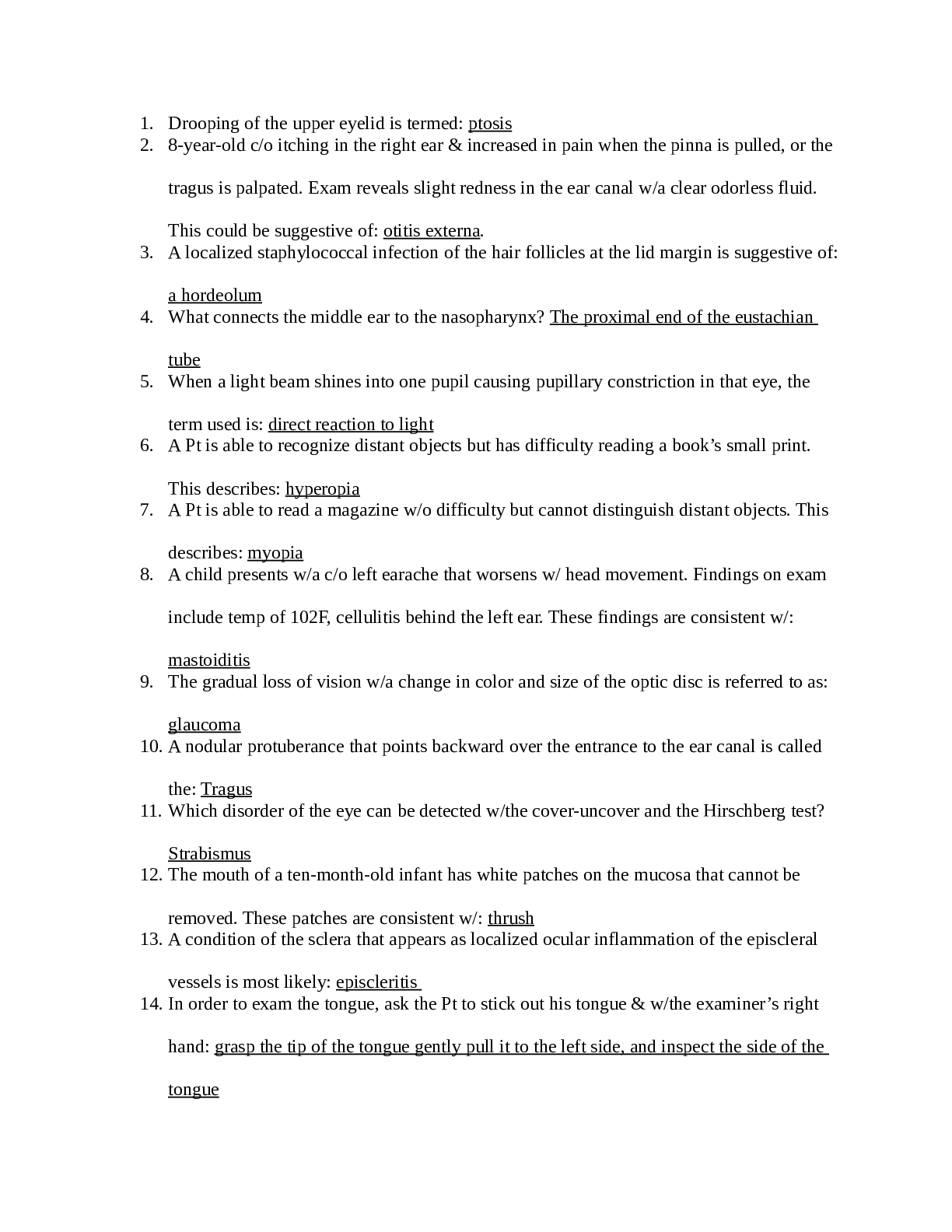*NURSING > EXAM > NSG 6440 Predictor Test latest Complete Solutions (Elaborated) | South University, Savannah - NSG644 (All)
NSG 6440 Predictor Test latest Complete Solutions (Elaborated) | South University, Savannah - NSG6440 Predictor test
Document Content and Description Below
Predictor test 1) A 15 years old high school student with a mild sore throat and low-grade fever that has persisted for about 3 weeks. She reports general malaise, fatigue, and loss of appetite. The N... P suspects mononucleosis. Which of the following is the LEAST appropriate intervention? a. Palpate the lymph nodes and spleen b. Examine the posterior oropharynx for petechiae c. Obtain a CBC, throat culture, and heterophil antibody test. d. Obtain an urinalyses and serum for LFTs and amylase Explanation: mononucleosis is a symptomatic infection caused by the Epstein-Bar virus. Common is people 15-24 years of age. Common signs and symptoms following incubation period (1-2 months) include fatigue, chills, malaise, anorexia, white tonsillar exudates and lymphadenopathy or posterior cervical region. Splenomegaly can be present. A maculopapular or occasionally a petechial rash occurs in less than 15% of patients. A diagnosis is usually made using the Monospot. In addition, neutropenia and lymphocytosis are usually detected in the CBC. 2) A 32 years old male patient complaint of urinary frequency and burning on urination for 3 days. Urinalyses reveals bacteriuria and positive nitrites. He denies any past hx. Of urinary tract infections. The initial treatment should be: a. trimethoprim-sulfamethoxazole (Bactrim, Sulfatrim) for 7-10 day b. ciprofloxacin (Cipro) for 3-5 days c. Trimethoprim-Sulfamethoxazole for 3 days d. 750 mg ciprofloxacin as a one-time dose Explanation: trimethoprim-sulfamethoxazole (TMPS) is usually n appropriate medication to treat urinary tract infections in most patients. In the case of community resistance to TMPS >20%^, another medication should be substituted. In men, the appropriate length of time is 7-10 days. Women may be treated for 3 days for uncomplicated UTI 3) Which agent is most effective for the treatment of nodulocystic acne? a. Benzoyl peroxide (Benzac) b. Retinoic acid (Retin A) c. Topical tetracycline d. Isotretinoin) Explanation: Isotretinoin (Accutane) is a systemic agent indicated for treatment with severe inflammatory acne. Guidelines for its use must be clearly understood by the patient. A woman of childbearing age must use an effective method of contraception because isotretinoin is teratogenic. There are many restrictions in prescribing this medication because of the teratogenic effects is given during pregnancy. Therefore, it is a pregnancy category X. 4) An 18 y/o woman is taking a combined hormonal oral contraceptive. She should be instructed to use a backup method for the prevention of pregnancy a. Throughout the week of placebo pills b. If prescribed topiramate (Topamax) for the treatment of migraines. c. If prescribed amoxicillin/clavulanate (Augmentin) for a sinus infection d. if she forgets to take a single dose of the contraceptive Explanation: Anticonvulsant including phenytoin (Dilantin), carbamazepine (Tegretol), primidone (Mysoline), topiramate (Topamax) and oxcarbazepine (Trileptal) reduce the effectiveness of contraceptives. Depo-medroxyprogesterone acetate injections or levonorgestrel-releasing intrauterine devices would be a better method of contraceptive for patients taking anticonvulsants. Most commonly used antibiotics have not been proven to reduce the effectiveness of contraceptives. Rifampin is an exception, and additional …. Be used by women taking this drug and using oral contraceptives, transdermal, or vaginal ring preparations. Additional backup contraception should be used if taking antifungal agents. No additional protection is needed thought the week of placebo pills. Missing one single dose of contraceptive does not require additional protection, missing more than one doses does. 5) A 44 years old female patient has diabetes. Her total cholesterol (TC) is 250 mg/dl (6.5 mmol/L), LDL= 190 mg/dL (4.94 mmol/L), HDL= 25 mg/dL (65 mmol/L), and triglycerides= 344 mg/dL (8.94 mmol/L). What agent have the greatest effect on improving her lipid profile and reducing morbidity and mortality associates with dyslipidemia? a. Niacin (Niaspan) b. Atorvastatin c. Omega 3 fatty acids d. Fenofibrates Explanation: First and foremost, it is essential to educate individuals on a heart-healthy lifestyle. LDL-C is one of the major culprits in the development of atherosclerotic heart disease. The target level of LDL-C is between 50 to 70mg/dl to prevent plaque formation in the blood vessels. Guidelines strongly recommend statin therapy because they primarily lower LDL-C levels, but they also have the secondary effects of lowering triglyceride and increasing HDL-C levels. 6) A 30 years old female comes into a clinic with classic signs and symptoms of appendicitis. The NP fails to refer the patient to a surgeon. The appendix ruptures and the woman die. This is an example of a. Failure of diligence b. Professional liability c. Negligence d. Malpractice Explanation: malpractice, a negligence tort, occurs when a health care professional’s actions fall bellow the appropriate standard of care and hurts the patient. In this case the patient came with sings and symptoms indicating appendicitis and the NP failed to refer the patient.. 7) A NP has recently been hired to work in a fast track facility. The NP employer asked if she has “a problem prescribing medications for emergency contraception.” The NP replies affirmatively. This is: a. Grounds for dismissal b. An ethical dilemma for the NP c. Illegal according to the standards of nursing d. Patient abandonment. Explanation: in this instance, the NP has a difference of opinion with her employer based on her religious or moral belief about providing emergency contraception. This situation is an example of an ethical dilemma. Failure to participate in the provision of care to the patient based on the NP’s beliefs is neither against the law nor a violation of the standards of practice 8) A patient presents with pruritic lesions on both knees. There are visible silver scales. How Should this condition be managed? a. Topical antifungal cream or ointment b. Oral antibiotics c. Topical corticosteroids cream d. Topical anti-fungal/ steroid cream Explanation: Psoriasis is characterized by erythematous papules, as well as itchy, red, precisely defined plaques with silvery scales. Auspitz sings is another common finding. Topical agents containing tar and salicylic acid may be used. Topical steroids, such as betamethasone, may also be ordered. 9) Antidepressant discontinuation syndrome is less likely if the patient a. Is male b. Is less than 35 y/o c. Has taken an SSRI with a short half life d. Gradually tapers SSRI use Explanation: Antidepressant discontinuation syndrome is most often seen in the primary care office in association with SSRI discontinuation, because SSRIs are the most commonly prescribed class of antidepressant medications. Interruption of treatment with an anti-depressant medication is sometimes associated with an antidepressant discontinuation syndrome; in early reports it was referred to as a “withdrawal reaction. Symptoms of antidepressant discontinuation syndrome can include flu-like symptoms, insomnia, nausea, imbalance, sensory disturbances, and hyperarousal. Tapering is recommended by experts. 10) Patient with benign prostatic hyperplasia (BPH) should be taught to avoid which one of the following drug classes? a. Alpha adrenergic antagonist b. Anti-androgen agents c. Tricyclic antidepressant (TCA) d. Sulfonamides Explanation: tricyclic antidepressant should not be used by men with benign prostatic hyperplasia because of the increased risk of urinary retention secondary to the anticholigergic effects of TCAs. 11) Which of the following is the best response to a woman who has just admitted she is a victim of spousal abuse? a. What was if you did to make him angry? b. You must seek refuge immediately c. I am concerned about your safety d. I am going to call a shelter for you Explanation: The first step is to establish trust in the therapeutic relationship. without trust future collaboration, intervention and client outcome cannot be accomplished to facilitate appropriate and safe behavior. The experience of abuse is a traumatic psychological crisis that must be addressed as such. The healthcare providers must emphasize the fact that the victim has not done anything wrong and they must also emphasize the fact that the victim's life and the lives of their children can be in danger if the abuse is not addressed. It will not disappear with a lack of action. An order of protection against the perpetrator is often recommended. 12) For which patient group does the US Preventive Services Task Force recommend routine screening for asymptomatic bacteriuria a. pregnant woman b. Children c. Patients with diabetes d. patients over the age of 70 Explanation: an increased incidence of bacteriuria is found in all the population listed. However, bacteriuria in pregnant women increases the mother…..Also increased is the risk of a pre-term delivery, which then increases perinatal and fetal morbidity and mortality. The recommended it…. 13) What diabetic complications result from hyperglycemia? 1. Retinopathy 2. Hypertension resistant to treatment 3. Peripheral neuropathy 4. Accelerated atherosclerosis a. 1,2,3 b. 2,3,4 c. 1,3,4 d. 1,2,4 explanation: Complications of untreated or uncontrolled hyperglycemia over a prolonged period of time include: Microvascular complications: Retinopathy, Nephropathy, Neuropathy Macrovascular complications: Coronary artery disease, Cerebrovascular disease, Peripheral vascular disease 14) A 6 y/o presents w/ complaints of sore throat and fever for 2 days. He has multiple vesiculated ulcerations on his tonsils and uvula. There are no other remarkable findings. What is the most likely diagnosis? a. Viral pharyngitis b. Herpangina c. Epiglottitis d. Tonsillitis Explanation: Herpangina is a viral infection common in toddlers and young children caused by Coxsackie virus. The clinical findings of numerous, small (1-2 mm) ulcerations on the tonsils and uvula are typical of herpangina. The ulcerations can be very painful but usually resolve in 7 to 10 days. Treatment is symptomatic. 15) A patient has Kawasaki syndrome. Which characteristics would be UNUSUAL? a. Age > 15 years b. Fever > 101 F (38.3 C) c. Exudative pharyngitis d. Painful rash explanation: Kawasaki disease is an acute febrile vasculitis syndrome that evolves inflammation of the blood vessels. This condition often causes cardiac complication in children by damaging the coronary arteries is most prevalent in children of Asian ethnicity. Diagnosis of Kawasaki disease requires presentation of fever and 4 of the following criteria: bilateral bulbar conjunctival injection, oral mucous membrane changes, peripheral extremity changes, polymorphous rash, and cervical lymphadenopathy. 16) According to the JNC 8 guideline hypertension in a 40 y/o can be diagnosed when blood pressure exceeds a. 140/90 b. 130/90 c. 125/85 d. 150/100 Explanation: According to JNC 8 guidelines, hypertension is a sustained elevation of systolic BP greater than or equal to 140 mmHg or diastolic BP greater or equal than 90mmHg, taken from 2 or more readings on 2 different occasions after an initial screening. 17) A 48 y/o female complains of pain and stiffness in her right hip and knee that is mild on awakening in the morning, get worse as the day progresses and is relived with hot baths and ibuprofen. Crepitus is palpated on range of motion of the knee. Signs of inflammation are notably absent. What is the most likely diagnosis? a. Rheumatoid arthritis (RA) b. Gout c. Osteoarthritis (OA) d. Osteoporosis Explanation: Rheumatoid arthritis is characterized by several joint deformities, usually bilaterally symmetrical. RA is characterized by inflammatory processes, while OA is not. RA and OA are chronic conditions. Gout is characterized by acute exacerbations related to a defect in purine metabolism, increased uric acid production, or decreased uric acid excretion. 18) A 7-year old female patient presents with severe injuries that are inconsistent with the explanation given for them. The nurse practitioner questions the mother about abuse. She admits that her husband, the child’s father, beat the child. How should the nurse practitioner proceed? a. Inform the mother that the abuse must be reported to child protection authorities. b. Counsel the mother that if it happens again it will be reported to child protection service. c. Ask the child what she did to cause the punishment d. Refer the family to the National Domestic Violence hotline. Explanation: An awareness of all the unique presentations of child abuse, subjective or objective, physical, sexual, or neglect, is essential for NPs. Objective findings, such as broken bones, burns, and bruises, may be as a result of an intentional injury from physical abuse or from an unintentional injury as a result of neglect. Both must be considered. Repeated visits to the emergency department, frequent or suspicious injuries, or bilateral or multiple healing fractures are often indicators of physical abuse. Once the diagnosis of child abuse has been made, the primary role of the NP is to ensure the child is safe. If the NP suspect that a child is undergoing abuse, it’s critical to report it—and to continue reporting each separate incidence if it continues to recur. 19) A 1-month-old presents with reported recurrent diarrhea, screaming, and drawing up of the legs followed by periods of lethargy. On physical examination, a “sausage-like” mass in the upper right quadrant of the distended abdomen. Which of the following is the most likely diagnosis? a. Intussusception b. Volvulus c. Crohn’s disease d. Foreign body in the GI tract explanation: Intussusception is one of the most common causes of abdominal obstruction in children prior 2 years of age; is best described as a portion of the intestine which telescopes into a more distal intestinal segment. The classic triad of intussusception include crampy (intermittent, also known as colicky) abdominal pain, vomiting, and bloody stools. The patient may pull up his knees with crying. The patient may develop vomiting with bilious emesis. Progressive lethargy/altered level of consciousness and pallor is common. The etiology of this lethargic presentation is not known, but it tends to occur in younger infants. As intussusception progresses, a palpable, sausage-shape mass may develop. Some hypothesize that this is due to release of endogenous opioids or endotoxins released from ischemic bowel. Intussusception in a child presenting with lethargy is often difficult to diagnose since other causes of lethargy such as dehydration, hypoglycemia, sepsis, toxic ingestion, post-ictal state, etc., must also be considered. Ultrasound is the preferred diagnostic test. Enemas is considered the first line of treatment prior surgery. Volvulus occurs more frequently in middle-aged and elderly men. Cronos’s is most often diagnosed between 13 – 30 years of age. 20) A middle-aged female complains of insomnia, night sweats, feeling intensely hot, emotional lability, extreme nervousness and impatience. The LEAST likely cause of her symptoms is a. Thyrotoxicosis b. Menopausal vasomotor instability c. Alcohol or another drug withdrawal d. New onset type 2 diabetes mellitus Explanation: New onset diabetes produces elevated serum glucose levels less than 200 mg/dL (7.0 mmol/L) and usually no clinical signs or symptoms. At higher levels, the patient may report lethargy, fatigue, weakness, weight loss, and polydipsia, polyuria, and/or polyphagia. Complaints of insomnia, night sweats, feeling intensely hot, emotional lability, and extreme nervousness may be caused by thyroxine excess, menopausal instability, or withdrawal from alcohol or other drugs of addiction. 21) Which of the following indicated need for further evaluation? a. A 7 y/o girl with vaginal bleeding b. A 7 years old girl with no true pubic hair c. A 12 years old boy with sparse, slightly pigmented pubic hair d. A 12-year-old girl with breast buds explanation: In newborn girls, withdrawal bleeding may occur as a normal response to maternal estrogen leaving the infant’s uterine lining. Vaginal bleeding after the first few weeks of life and before puberty is considered abnormal. Early vaginal bleeding can indicate trauma, foreign bodies (toilet paper is the most common), vulvovaginitis, hemangiomas, benign polyps, precocious puberty, or sexual abuse. 22) A young couple is being seen by the NP for preconception counseling. They express a wish for pregnancy within the next 3 month and are very eager to know what they can do now to “make the baby as healthy as possible”. Which of the following should the NP encourage to decrease the chance of neural tube defect in the fetus? a. Maternal alpha-fetoprotein level b. Folic acid 0.4 mg daily c. Rubella vaccine today d. Vitamin E 400 IU daily Explanation: Supplementation with folic acid decreases the development of neural tube defects, such as spina bifida and anencephaly. Folic acid plays an essential role in neural tube closure. Neural tube development/closure takes place in the fist 4 weeks of embryonic life (6 weeks’ gestation). U.S. Public Health Service and the CDC recommend that all women of childbearing age consume 0.4 mg of folic acid daily to prevent tube defects. 23) A patient with a past history of documented coronary arterial blockage less than 70% complains of chest pain several time p…. which is relived with nitroglycerin. Which is the most appropriate initial action for the NP? a. Refer to a cardiologist as soon as possible b. Prescribe long-acting nitroglycerin c. Order treadmill stress test d. Prescribe an ACE inhibitor and re-evaluate in 24 to 48 hours Explanation: The patient has at least a 70% occlusion of a major coronary artery. For a patient to be considered for CABG, the coronary arteries to be bypassed must have approximately a 70% occlusion (60% if in the left main coronary artery). 24) A 3 y/o has enlarged, warm, tender cervical lymph nodes, indicating: a. Infection proximal to the nodes b. A possible cancer diagnosis c. Shorty nodes, a common normal variant in children d. An infectious process distal to the nodes explanation: size of lymph nodes is important. Nodes > 1 cm are significant and should be asses carefully. Nodes > 5 cm are almost always neoplastic. Tenderness of a node usually suggest inflammation. Cancerous nodes frequently are larger, non-tender, and stone-like in consistency. Nodes are pea-sized, non-tender, mobile, discrete and reflect pre-existent infection. 25) The NP examines a 2-month-old with unequal gluteal and thigh skin folds. What should the NP do next? a. Send the infant for x-ray of the hips b. Send the infant for ultrasound of the hips c. Perform Ortolani and Barlow test d. Examine the infant for unequal arm length Explanation: Gluteal and thigh skin fold asymmetry may indicate congenital hip dysplasia. X-ray studies are not useful before 3 months-of-age because the femoral head has not completely ossified. 26) A very active 35 years old male has painful hemorrhoid, but he does not want hemorrhoidal surgery at this time. His diet has been indiscriminate as his job requires frequent travel. The most appropriate recommendation is for him to select food that are: a. Low in fiber such as milk and other dairy products b. High in simple carbohydrates such as white bread and mashed potatoes c. High in fiber such as bran, complex carbohydrates and fresh fruit d. High protein such a meat, poultry and fish Explanation: Hemorrhoid disease is the most common reason patients seek evaluation by a colon and rectal surgeon. The majority of hemorrhoids can be managed nonoperatively with medical management or office-based procedures. Patients should benefit from minimizing straining and avoiding constipation. Bulking of the stool facilitates this and can be accomplished by increasing dietary fiber and fluid intake. Stool softeners may also be used. 27) Correct instructions to give new parent who are transporting their newborn infant is a. A rear-facing infant car seat secured in the backseat is required until the infant weight 20 lbs. b. The infant car set may be secured in the back or front seat, but must rear-facing c. The infant car seat may be front facing when the infant is 1 year old d. A rear or front-facing infant car seat must be secured in the back seat until the infant weight 20 lbs. Explanation: The American Academy of Pediatrics (AAP) recommends that infants and toddlers ride in a rear-facing seat until they are 2 years old or until they have reached the maximum weight and height limits recommended by the manufacturer 28) A 13 y/o pt. complains that he fell while running during football practice. Now his knee hurts and sometimes “lucks”. The NP conducts McMurrays test. Which of the following is TRUE about this test? a. An audible or palpated “click” is positive for a torn meniscus b. A various stress is applied to the flexed knee c. The straight leg is internally rotated with the patient supine and flat d. The knee is grasped with the examiner’s fingers placed laterally. Explanation: Mac Murray’s test is conducted while the patient is in the supine position. The NP places the distal hand on the foot and raises the knee slowly, keeping the foot and knee externally rotated with the proximal hand resting on the join line. The knee is flexed and then quickly straightened. If an audible or palpable click occurs during the this test, the outcome is positive for medial meniscal injury. 29) A 20 y/o male patient complains of “scrotal swelling”. He states his scrotum feels heavy but denies pain. On examination, the NP notes transillumination of the scrotum. What is the most likely diagnosis? a. Hydrocele b. Orchitis c. Testicular torsion d. Indirect inguinal hernia Explanation: Hydrocele is common in newborns and usually disappears without treatment within the first year. Older men can develop hydroceles, sometimes due to inflammation or injury. Hydroceles are usually painless, but may become large and inconvenient. An ultrasound may be needed to diagnose the condition. 30) A 15 y/o male has a hx of cryptorchidism which was surgically repaired. Because of this information, it is essential for the NP to teach him about a. Testicular self-examination b. Protection of the testes during sports activities c. Risk of testicular torsion d. Practicing safer sex Explanation: Cryptorchidism, even with surgical repair, is associated with increased risk for testicular cancer. 31) A pt. present with classic symptoms of gastroesophageal reflux diseases’ (GERD). He is instructed in lifestyle modification, and drug initialed. Two month later, he returns and report that he still has symptoms. The next steps are to. a) Refer for surgical interventions such as partial or complete fundoplication. b) Refer for endoscopy, namometry, and/or PH testing c) Repeat the 8*-week course of drug therapy while continuing lifestyles modifications. d) Review proper proton pump inhibitor dosing time and adherence with the patient. Explanation: poor adherence is an importance cause of inadequate acid suppression and refractory GERD. Determining adherence to proton pump inhibitor (PPI) therapy and superficially timing in relation to meals, should be sought first alarm features such as iron deficiency anemia, unexplained weight loss, and persistent vomiting would precipitate the need for further diagnostic testing. Diagnostic testing procedures should proceed any surgical intervention like fundoplication. 32) A 51 –year- old post-menopausal female, request guidance regarding osteoporosis risk. The NP would be correct to recommend all of the following EXCEPT a. Moderate weight bearing exercise 3 times per week b. 1200 – 1500 mg calcium daily c. Avoidance of alcoholic beverages d. Weight loss Explanation: the recommended calcium intake is 1,200 mg – 1500 mg a day. Regular weight-bearing and muscle-strengthening exercise reduce the risk of falls and fractures. Moderate alcohol intake has no known negative effect on bone and may even be associated with slightly higher bone density and lower risk of fracture in postmenopausal women. However, alcohol intake of more than two drinks per day for women or three drinks a day for men may be detrimental to bone health, increases the risk of falling and requires further evaluation for possible alcoholism. In addition, Risk factors for osteoporosis include age greater than 65, white or Asian ethnicity, cigarette smoking, inactive lifestyle, low weight and postmenopausal estrogen deficiency including premature menopause. 33) According to Erickson, the developmental task of the elderly adult is: a. Intimacy VS isolation b. Ego integrity VS despair c. Industry VS self-doubt d. Trust Vs mistrust explanation: 34) Moderate weight loss, particularly of visceral adipose tissue in patients with type 2 diabetes mellitus may have all of the following beneficial effects EXCEPT: a. Improved insulin sensitivity b. Increased glucose uptake and utilization by the cells c. Increase lean muscle mass’ d. Improved lipid profile Explanation: Regular, consistent exercise is an essential part of diabetes and prediabetes management. The ADA recommends that people with diabetes perform at least 30 minutes, 5 days/wk of a moderate-intensity aerobic physical activity. The ADA also encourages people with type 2 diabetes to perform resistance training 3Xwk in the absence of contraindications. Exercise contributes to weight loss, which further decreases insulin resistance. The therapeutic benefits of regular physical activity may result in a decreased need for diabetes medications to reach target blood glucose goals. Regular exercise may also help reduce triglyceride and low-density lipoprotein (LDL) cholesterol levels, increase high-density lipoprotein (HDL), reduce BP, and improve circulation. Patients who use insulin, sulfonylureas, or meglitinides are at increased risk for hypoglycemia when they increase physical activity. 35) A 12 y/o presents with eat pain or 36 hours duration. The NP diagnoses acute otitis media because the a. Tympanic membrane is bulging and glossy with tiny bubbles visible posteriorly b. Tympanic membrane is retracted against boy landmarks c. Bony landmarks are obscured, and the tympanic membrane is mildly erythematous, dulls and immobile. d. Canal is narrowed, erythematous, and exquisitely tender with speculum contact Explanation: Serous otitis media typically presents with a flat or bulging and tympanic membrane with a fluid line and/or tiny bubbles visible posteriorly. The tympanic membrane may be immobile and retracted against the bony landmarks when the eustachian tube is swollen or congested as with the common cold or allergies. Narrowing of the external canal with erythema and extreme tenderness of the canal wall is indicative of otitis externa. 36) The NP should instruct the mother of an infant with thrush to: a. Take oral nystatin since she is breastfeeding b. Stop breast feeding until the thrush has resolved c. administer antifungal medication to the infant prior to feeding d. sterilized pacifiers and bottle nipples explanation: Most bouts of oral thrush occur for no apparent reason. However, regularly sterilization of pacifiers, bottles-feed and other mouth toys used by the baby may help to prevent some bouts. 37) A 26 y/o patient, 18 weeks pregnant with twins, has been healthy and has followed recommendations of her nurse midwife. She is in the office to discuss results of her maternal serum alpha-fetoprotein (MSAFP) test. which show elevation in this particular pregnancy? a. Elevated MSAFPO is an indicator of Down Syndrome b. Low MSAFP is expected at 18 weeks’ gestation c. Neural tube defects are highly probable d. Elevated MSAFP is an expected finding Explanation: elevated maternal serum alfa Protein is expected when a woman is pregnant with twins. An elevation can also be an indication of a miscalculated due date. Low levels can indicate Down Syndrome 38) The hallmark of neurofibromatosis (von Recklinghousen disease) present in almost 100% of patients is: a. Acoustic neuroma b. Astrocytoma of the retina c. Distinctive osseous lesion d. Café au lait spots Explanation: Von Recklinghausen disease is also known as neurofibromatosis. It is characterized by multiple neurofibromas, or tumors, forming that vary in shape, size, and location. Neurofibromatosis type 1 and neurofibromatosis are differentiated by clinical features. They both include benign tumors of the nerve tissue (neurofibromas). Only neurofibromatosis type 1 (90%) has prominent clinical features, such as cafe-au-lait pigmentation. Neurofibromatosis type 2 consists of neurofibromas only without clinical features. 39) The NP correctly teaches an elderly patient with pernicious anemia that food sources of B12 include a. Red meat, poultry, fish, eggs, dairy products b. Canned and frozen fruit c. Whole grain breads, cereals and pastas d. Fresh vegetables explanation: Pernicious anemia is a type of vitamin B12 anemia. VB12 can be found in foods such as meat, poultry, shellfish, eggs, and dairy products. A special protein, called intrinsic factor (IF), helps the intestines absorb vitamin B12. This protein is released by cells in the stomach. When the stomach does not make enough intrinsic factor, the intestine cannot properly absorb vitamin B12. 40) An 18-year-old female applying for college admission present to the health clinic because evidence of rubella vaccination is required for admission. She says, “don’t remember ever getting that shot” She has negative serologic evidence of rubella antibody. The NP should: a. Tell her that her serologic evidence demonstrates that she is immune to the rubella and that she probably has the disease as a child b. Administer the vaccination after a negative pregnancy test and advise the patient that she must not get pregnant for 28 days c. Tell her that she needs the immunization and can get today if her pregnancy test is negative d. Administer the rubella vaccination after a negative pregnancy test and advise her not to get pregnant for at least 6 months. Explanation: Due to this very small chance of illness, the Centers for Disease Control and Prevention (CDC) recommend waiting 28 days after getting the MMR vaccine before trying to get pregnant. 41) A 45 y/o obese pre-menopausal female complains of indigestion, flatulence, RUQ pain and epigastric “crampy pain”. Symptoms are exacerbated by high-fat meal. What is the most likely diagnosis? a. Hepatitis b. Chronic cholecystitis c. Acute pancreatitis d. Myocarditis Explanation: The “typical” patient with chronic cholecystitis is “female, fat, fertile, and (over) 40” years of age. Myocarditis produces retrosternal pain that is not related to diet. The pain of pancreatitis radiates to the back. The pain of hepatitis is non-specific upper quadrant pain. 42) A 16 y/o male presents w/ mild sore throat, fever, fatigue, posterior cervical adenopathy, and palatine petechia. With for this patient, what drug would be the LEAST appropriate to prescribe? a. Ibuprofen b. Erythromycin c. Ampicillin d. Doxycycline Explanation: Mono can be managed with supportive care, including NSAIDs, and warm sailing gargles. patients with strep throat should be prescribed penny ceiling or every throw myosin instead of amoxicillin or ampicillin because amoxicillin and ampicillin often cause a rash in mono patients. 43) A characteristic of delirium that is typically absent in dementia is a. Acute onset of confusion in a previously alert and oriented patient b. Gradual loss of short-term memory c. Loss of language skills d. Long term memory gaps filled in with confabulation Explanation: Delirium is acute confusional state, is potentially a reversible cognitive impairment that often has a physiological cause; physiological causes include electrolyte imbalances, cerebral anoxia (an absence of oxygen); hypoglycemia; medication effects; tumors; subdural hematoma; and cerebral infection, infarction, or hemorrhage. Dementia is a generalized impairment of intellectual functioning that interferes with social and occupational functioning. It is an umbrella term that includes Alzheimer's disease, Lewy body disease, frontal-temporal dementia, and vascular dementia. 44) It is imperative that the NP teach patients taking oral contraceptives to report any of the danger signs of complications. Which of the following would be the LEAST concern to the NP? a. Lower leg pain b. Upper abdominal pain c. Chest pain d. Weight gain Explanation: Common side effects of OCP includes: bleeding between periods, nausea, breast tenderness, headaches and weight gain. The symptoms often subside after a few months of use. Lower Leg pain can be indicative of- DVT. Other major complication can include the liver, gallbladder or the cardiac organ. 45) Which of the following oral medications should be avoided in a child under 8 years of age? a. Cephalexin (Keflex) b. Tetracycline c. Rifampin d. Metronidazole (flaggyl) Explanation: Children younger than 8 years old should not take tetracycline. Deposition in the bone and primary dentition occurs during calcification in growing children. This causes discoloration and hypoplasia of the teeth and a temporary stunting of growth. 46) Which of the following descriptions of Denver II Developmental Screening Test is most accurate? a. Applicable to children from birth to 2 years; evaluates four major categories of development: motor, intellectual, emotional, and language to determine whether a child is within normal range for various behaviors or is developmentally delayed b. Applicable to children from birth to 5 years; evaluates four major categories of development: motor, vision, hearing and psychosocial to determine whether a child is normal or developmentally compromised c. Applicable to children from age 6 months to 6 years; evaluates 4 major categories of development: intellectual, verbal, social and memory to determine IQ and aptitude d. Applicable to children from birth to 6 years; evaluates four major categories of development: gross motor, fine motor-adaptive, language, and personal social to determine whether a child is within normal range for behaviors or is developmentally delayed. Explanation: The Denver Developmental Screening Test (DDST) is a screening test for cognitive and behavioral problems in children from birth until the age of 6 The purposes of the DDST and Denver II are to screen children or possible developmental problems and to verify suspected problems with an objective measure. The Denver II screens general development in four areas: Social – Personal: Aspects of socialization inside and outside the home – eg, smiling. Fine motor function – Adaptive: Eye/hand co-ordination, problem solving and manipulation of small objects – eg, grasping and drawing. Language: Production of sounds, and ability to recognize, understand and use language – eg, ability to combine words Gross motor functions: Motor control, sitting, walking, jumping, and overall large muscle movements. 47) A 12-month-old has conjunctivitis in his right eye with a mucopurulent discharge. The mother asks if the child can forego for antibiotic eye drops because he does not’s like drops in his eyes. The NP replies that: a. If untreated, conjunctivitis may permanently damage the cornea b. Conjunctivitis is usually caused by a virus. Let’s wait a few days c. If no one else at the daycare has it, we can wait a few days. d. An oral antihistamine may be prescribed instead of eye drops. Explanation: Pink eye does not normally cause loss of vision, especially when treatment is administered in a timely manner. However, if bacterial conjunctivitis is serious and left untreated, it may damage the eye permanently, leading to loss of vision. 48) which oral hypoglycemic agent would be safest for an elderly patient if hypoglycemia is a major concern? a. Tolbutamide (orinase) b. Glipizide (Glucotrol) c. Metformin (Glucophage) d. Chlorpropamide (diabinese) Explanation: When used alone, metformin typically does not cause hypoglycemia and is usually weight neutral or causes modest weight loss. Given the low risk of hypoglycemia, metformin has an important role in elderly patients with diabetes, as long as patients are selected appropriately to avoid the risk of lactic acidosis. 49) the components of the Denver II Developmental screening test are: a. Personal/social, fine motor, gross motor, language b. Intelligence, motor performance, language development c. Vocabulary, clarity of speech, abstract thinking d. Problem-solving, speech, gross motor, fine motor Explanation: The Denver II Developmental Screening Test is the most widely used tool to assess early childhood development and rates the categories of personal–social, fine motor–adaptive, language, and gross motor skills. The nurse should explain to the parent before administering the test that this test does not measure intelligence but of the child's level of development or ability to perform age-appropriate tasks. DDST II Assesses: Gross motor function Language development Fine motor-adaptive skills Personal-social skills 50) A patient has been taking fluoxetine (prozar) since being diagnosed with major depression 7 month ago. She reports considerable empowerment in her symptoms and her intention to discontinue the medication what should be the NP’s recommendation? a. Advice the patient to stop the antidepressant medication b. Question the patient to determine if the self-assessment is correct before advising her to discontinue the medication c. Recommend that the patient continue the antidepressant medication for at least 4 more month d. Discuss with the patient that need to take the antidepressant medication indefinitely Explanation: Anxiety Treatment Clinical guidelines for managing MDD also recommend that patients should maintain antidepressant use for at least 6–9 months after full symptom remission and that patients with some risk factors. 51) for the general adult population, total dietary fat intake should be no more than what percent of total calories? a) 10% b) 20% c) 30% d)40% Explanation: Clinical trials suggest that heart disease mortality rates un the US could be lowered by 5 to 20% if all Americans restricted their fat intake to less than 30% of total daily calories, 7% from saturated fat. 52) A 30 y/o female patient is being seen by the NP for the first time. She is seeking advice from the NP about becoming pregnant. She is currently taking an oral contraceptive. She gives a hx of having hydatidiform molar pregnancy 2 years ago. An appropriate plan of care for this a. patient should include b. Delaying pregnancy for 1 more year c. Measuring serum chorionic gonadotropin level d. Discontinuing oral contraceptive e. Recommending permanent sterilization Explanation: A Women should be instructed to use birth control for 1 year after treatment for a hydatidiform mole. Pregnancy raises hCG levels which increases the risk for choriocarcinoma. 53) which of the following is NOT a goal for treatment for the patient with cystic fibrosis? a. Prevent intestinal obstruction b. Provide adequate nutrition c. Promote clearance of secretions d. Replace water soluble vitamins Explanation: most patients with cystic fibrosis have insufficient release of pancreatic enzymes. This results in malabsorption of the fat-soluble vitamins….meconium ileus , resembles appendicitis in these patients 54) A 24 y/o female taking oral contraceptive has missed her last 2 pills. What should the NP advise her to do to minimize her risk of pregnancy? a. Take today’s dose and do not miss any more during this month b. Double today’s dose and use a barrier method for the rest of this month c. Double today’s dose and tomorrow’s dose and use a barrier method for the rest of this month d. Stop the pills and restart a new pill pack in one week. Explanation: If 2 pills are missed on consecutive days, the next 2 days’ dosage should be double, and a barrier method recommended for the remainder of the cycle 55) Which red blood cell (RBC) index is most useful for differentiating types of anemias? a. Mean corpuscular volume (MCV) b. Mean corpuscular hemoglobin concentration (MCHC) c. Hematocrit (HCT d. Platelet count Explanation: The MCV is the most useful value in the RBC indices to help determine the type of anemia you may have. Your doctor will see if your MCV is low, normal, or high to help determine what is causing your anemia. 56) what is a Tzanck test used to diagnosed? a. Mastoiditis b. Trichomoniasis c. Hyphema d. Herpes virus Explanation: Tzanck prep is the only test in this list which is diagnostic for herpes simplex. KOH prep is used to diagnose candidal and bacterial vaginosis. Gram stain is used to help distinguish Gram positive and Gram negative organisms. The Papanicolaou (Pap) smear is used to screen for cervical dysplasia and cancer. 57) a 40 y/o female with hx. Of frequent sun exposure present with multicolored lesion on her back it has irregular borders and is about 11 mm in diameter. What should the NP suspect? a. Squamous cell carcinoma b. Malignant melanoma c. Common Nevis d. Basal cell carcinoma Explanation: ABCDE RULE Another commonly used tool for early detection of melanoma is the ABCDE acronym (Asymmetry, Border irregularity, Color variation, Diameter >6mm and Evolution or history of change) introduced to alert patients and health professionals to the diagnosis of melanoma. 58) a 16 y/o sexually active female presents to the clinic. She has never had vaccinations for hepatitis A or B. She has had one MMR immunization, and her last tetanus vaccination was 4 years ago. which vaccination would be contraindicated without further testing? a. Hepatitis B b. Hepatitis A c. MMR d. Tetanus Explanation: Patient should have a pregnancy test before MMR vaccine. The MMR vaccine is contraindicated during pregnancy because it contains live, attenuated viruses that pose a theoretical risk to the fetus 59) following the finding of prostate gland abnormalities on DRE, The NP orders appropriate labs. When preparing to review with the patient, the NP knows all of the following are true EXCEPT a. Normal PSA is 10 mg/ml or less b. PSA is elevated in the presence of malignant prostate epithelium c. PSA is elevated in the presence of BPH d. Positive serum acid phosphatase reflects malignancy of the prostate gland with bone metastasis. Explanation: The effect of digital rectal examination (DRE) on serum PSA levels is still debatable. ... Although, there was a statistically significant increase in serum PSA levels 30 min after DRE, the clinical significance of this increase in PSA values with a mean difference of 0.4 ng/ml remains to be clarified. 60) in which of the following presentations is further diagnostic testing NOT warranted? a. Bilateral gynecomastia in a prepubertal male of average weight; Tanner stage 1 b. Bilateral gynecomastia in a 13 y/o male with normal testicular size and volume c. Recent onset gynecomastia in a 20-year-old male with breast tenderness d. Unilateral breast mass which is 5 centimeters in diameter Explanation: Gynecomastia is the benign enlargement of male breast glandular tissue and is the most common breast condition in males. Pubertal gynecomastia usually begins at age 10-12-years-old and peaks at ages :// 61) a 59 years old post-menopausal woman has atrophic vaginitis. She has a hx. Of breast cancer at age 40 years. What is the appropriate initial treatment for this patient? a. Oran conjugated estrogens b. Oral medroxyprogesterone aetate c. Topical medroxyprogesterone aetate d. Topical conjugate estrogen cream Explanation: PREMARIN (conjugated estrogens) Vaginal Cream is a mixture of estrogens indicated for: Treatment of Atrophic Vaginitis and Kraurosis Vulvae Treatment of Moderate to Severe Dyspareunia, a Symptom of Vulvar and Vaginal Atrophy, due to Menopause. 62) Advances in obstetric and neonatal care have a. Helped to identify the cause of cerebral palsy b. Demonstrated the cerebral palsy is a direct result of birth asphyxia c. Has no effect on the incident of cerebral palsy d. Resulted in a dramatic decrease in the incidence of cerebral palsy Explanation: Cerebral palsy is a common, non-progressive, encephalopathy that is believed to be from a defect in the developing brain. Improvements in perinatal care have not affected the incidence. 63) which of the following physical modalities recommended for treatment of rheumatic arthritis provides the most effective long-term pain relief? a. Superficial and deep heat b. Application of cold c. Transcutaneous electrical nerve stimulation (TENS) d. Exercise Explanation: exercise is most consistently effective in reducing the pain associated with rheumatoid arthritis. Exercise improve blood flow, cartilage health, range of motion. Exercise can also improve self-efficacy. Patients with RA should be cautioned to limit joint range of motion, and/or splint affected joints during acute…..Heat, cold, and TENS application can also have a role in pain relief. 64) The NP is counseling a 25 y/o sexually active male patient about condom use, which of the following statement is INCORRECT a. Adequate lubrication is needed to prevent damage to the condom b. Roll the condom over an erect penis before any sexual contact c. Make sure the condom is tight against the head of the penis d. Withdraw while the penis is erect, so that the condom stays in place Explanation: Condoms come in all different types and sizes. Condoms that are too tight can choke off blood supply, which contributes to erectile dysfunction. And if you choose a condom that’s too big, it can slip off during intercourse, which not only defeats the purpose of wearing the condom but can also undo an erection. 65) a patient with moderate persistent asthma will probably be most effectively managed with daily a. Oral leukotriene blockers b. Short and long acting bronchodilators c. Inhaled steroids and long acting bronchodilators d. Oral steroids and short acting bronchodilators Explanation: People with moderate persistent asthma are not well controlled on low doses of inhaled corticosteroids. A combination of this drug and long-acting inhaled beta2 agonists provides improved control compared with doubling of the maintenance dose of inhaled corticosteroids. 66) diagnosis of systemic lupus erythematosus (SLE) is made a. On the basis of demonstrable anti-nuclear antibodies (ANA) b. Considering symptom complex with confirmation by laboratory test c. Using renal function studies and rheumatoid factor for confirmation d. On the basis of renal or cutaneous biopsy Explanation: The American College of Rheumatology has proposed the revised criteria for diagnosis of systemic lupus erythematosus (SLE) abnormalities associated with disease. At least four of these criteria are required to make the diagnosis. Laboratory test…. 67) which of the following would not be considered a developmental red flag to a NP assessing a 4 y/o? a. Persistent fear of going to sleep b. Missing speech sounds c. Fire-setting d. An imaginary friend Explanation: The parents need to understand that the child's behavior is not uncommon. Imaginary friends are common in the preschool-age child. The child's behavior is not abnormal. The child does not have a deep-set psychological need. The child is not at risk for social isolation. 68) A 44 y/o patient complains of stuffiness and soreness in his hands, hips and knees. There is noticeable PIP and DIP joint enlargement in his hands.. The NP suspects arthritis. All of the following questions are helpful in differentiation between rheumatoid arthritis (RA) and osteoarthritis (OA) EXCEPT a. on the joint of your fingers never feel particularly warm or hot? b. tell me about your usual energy level c. does the soreness and stiffness get better or worse as the day progresses? d. Have you noticed decreased joint movement or flexibility? Explanation: Limited range of joint motion is characteristic of both types of arthritis. The soreness and stiffness associated with OA improves as the day progresses and joint range of motion improves with the performance of daily activities. Joint pain and stiffness associated with RA worsens with use. Loss of energy, malaise, and easy fatigability are constitutional symptoms associated with RA. RA is an inflammatory disease of the joints and flare-ups are characterized by very warm and erythematous joints relieved by anti-inflammatory medications such as NSAIDs and glucocorticosteroids 69) An adult presents w/ tinea corpus. What comment by the patient would be the LEAST likely explanation of how he acquired this disease? a. "I trap animals" b. "my wife has this also" c. "I have diabetes" d. "I live in the Northern US" Explanation: A ringworm infection can be spread in many direct and indirect ways, including: Person to person, Pet/animal to person, Inanimate item to person: It’s possible to get ringworm through indirect contact with objects, including hair of an infected person, bedding, clothing, shower stalls, and floors, Soil to person, having a weak immune system. 70) Acute rheumatic fever is diagnosed using the modified Jones criteria. Which is NOT a major criterion in the Jones System? a. Jaundice b. Carditis c. Polyarthritis d. Subcutaneous nodules Explanation: One of the major criteria for diagnosis of acute rheumatic fever using the Jones System is polyarthritis, the most common finding. This usually responds to aspirin therapy within 48 hours. Another common finding is carditis. Other major criteria which are far less common include erythema marginatum and subcutaneous nodules. 71) A pt is taking an ACE inhibitor for the blood pressure control. The NP decides to add a diuretic which of the following is the best choice? a. a thiazide diuretic b. a loop diuretic c. a potassium-sparing diuretic d. Fitness bar Explanation: A ringworm infection can be spread in many direct and indirect ways, including: Person to person, Pet/animal to person, Inanimate item to person: It’s possible to get ringworm through indirect contact with objects, including hair of an infected person, bedding, clothing, shower stalls, and floors, Soil to person, having a weak immune system. 70) Acute rheumatic fever is diagnosed using the modified Jones criteria. Which is NOT a major criterion in the Jones System? e. Jaundice f. Carditis g. Polyarthritis h. Subcutaneous nodules Explanation: One of the major criteria for diagnosis of acute rheumatic fever using the Jones System is polyarthritis, the most common finding. This usually responds to aspirin therapy within 48 hours. Another common finding is carditis. Other major criteria which are far less common include erythema marginatum and subcutaneous nodules. 71) A pt is taking an ACE inhibitor for the blood pressure control. The NP decides to add a diuretic which of the following is the best choice? e. a thiazide diuretic f. a loop diuretic g. a potassium-sparing diuretic h. Fitness bar Explanation: First-line and later-line treatments should now be limited to 4 classes of medications: thiazide-type diuretics, calcium channel blockers (CCBs), ACE inhibitors, and ARBs. 72) which of the following drugs classes would be most effective in decreasing elevated triglycerides levels (650 mg/dL)? a. bile acid sequestrants b. nicotinic acid c. fibrates d. statins Explanation: Classes of medications that are appropriate for the management of major triglyceride elevations include fibric acid derivatives, niacin, and omega-3 fatty acids. 73) the mother of a 16 y/o high school student athlete is concerned that her daughter has not had a menstrual period yet. on physical examination, the NP finds normal growth and development including appropriate secondary sexual characteristics what is the most appropriate NP action? a. refer to a endocrinolist b. order a pelvic ultrasound c. attempt progesterone challenge d. prescribe oral contraceptive Explanation: Normal age for menarche is between nine and 17. Since this patient has secondary sexual characteristics and normal anatomy, she should be offered reassurance that she is normal and her menses will probably start soon. 74) factors known to be associated with early sexual activity include. a. early development of secondary sex characteristics, living in an urban area, and easy access to contraceptives b. legalized abortion, frequent viewing of adult television and movies, and lack of church affiliation c. lower socioeconomic status, use of tobacco, alcohol or other drugs, and single parent household d. exposure to sex education information at school Explanation: Factors found to be associated with early sexual activity are lower socioeconomic status, use of tobacco, alcohol, or other drugs, and belonging to a single parent household. 75) the finding which is most consistent with a diagnosis of benign prostatic hyperplasia is digital palpation of prostatic gland that is a. enlarged, symmetrical, semi firm and non-tender b. enlarged, symmetrical, boggy and exquisitely tender c. asymmetrical and nodular d. exquisitely tender with absence of median sulcus Explanation: During the digital rectal exam, the practitioner palpates the prostate, noting its size, shape, and consistency and any nodules or tenderness. The normal prostate is rubbery and nontender. With BPH, the prostate feels symmetrically enlarged, firm, slightly elastic, and smooth. A distinct, hard nodule may signal a malignancy. 76) The NP correctly diagnoses iron deficiency anemia in a female patient whose lab report reveals a. an increase reticulocyte count b. a mean corpuscular volume (MCV) > 100 c. hemoglobin (hgb) 140 mg/dL (140 g/L) d. an increased total iron binding capacity (TIBC) Explanation: A total iron binding capacity value above 450 mcg/dL usually means that there's a low level of iron in your blood. This may be caused by a lack of iron in the diet, increased blood loss during menstruation, pregnancy, or a chronic infection. 77) Strabismus is observed in a 13-month-old child. The most appropriate action for the NP to take a. refer the patient to an ophthalmologist b. patch the child affected eye c. follow the child closely for 2 more month d. teach the patient and parent, eye muscle exercises Explanation: Strabismus can also be an indicator of severe eye and health problems. As it can indicate poor vision, it may in rare cases be the first sign of childhood cataract, glaucoma, or tumors of the eye, optic nerve, orbit or brain, such as retinoblastoma, glioma, or rhabdomyosarcoma. 78) giving appropriate patient education by the primary care provider, poor compliance with medical recommendations is most often due to: a. willful disobedience b. vision and/or hearing deficits c. anxiety d. limited cognitive ability Explanation: In the National adult Literacy Survey, 75% of Americans with chronic or mental health problems scored in the lowest 2 out of 5 …. Literacy. Among the elderly, minorities, and lo income groups, 2/5 cannot read the simple brochure. Most patients are not likely to volume….. 79) the physical exam findings in an infant are most effected by which item listed below? a. what was the Apgar score at one minute? b. is the child breast of bottle fed? c. are the immunizations current? d. what was the gestational age at birth? Explanation: Gestational age is the most important predictor of growth impairment, followed by birth weight and length standard deviation scores. 80) Babies should begin oral iron supplementation: a. when they are able to eat iron enriched cereal b. 2 months of age c. 4-6 months d. any time after their teeth have erupted Explanation: Recommends giving breastfed infants 1 mg/kg/day of a liquid iron supplement until iron-containing solid foods are introduced at about 6 months of age. 81) the most common cause of cerebral palsy is a. unknown b. intra-partial hypoxia c. in utero infection d. intraventricular hemorrhage Explanation: in approx. 70% of cases, neither cause (s) nor risk factors can be identified as correlates to cerebral palsy 82) A patient with diabetes bring his glucose dairy from the past 7 days for the NP to review and evaluate what changes should be made? DAY AM 67, 52, 61, 48, 39, 68, 70 PM138, 161, 148, 168, 171, 142, 176 a. increase the PM dose of NPH insulin b. increase the PM dose of regular insulin c. decrease the PM dose of NPH insulin d. decrease the PM dose of regular insulin Explanation: NPH Human Insulin which has an onset of insulin effect of 1 to 2 hours, a peak effect of 4 to 6 hours, and duration of action of more than 12 hours. 83) which of the following patient is at highest risk of suicide? a. 65 y/o female b. 70 y/o male c. 35 y/o white divorce male d. 42 y/o single mother Explanation: There is a common perception that suicide rates are highest among the young. However, it is the elderly, particularly older white males that have the highest rates. And among white males 65 and older, risk goes up with age. White men 85 and older have a suicide rate that is six times that of the overall national rate. 84) a 17 y/o male is brought into the clinic by his mother who says that is there are no medical consequences or risk known, she will allow her son to get a possible. How should the NP respond? a. tattoos distort one’s body image resulting in high possible of depression b. tattoos and body piercing are possible sources of hepatitis C infection if there is a common use of contaminated needles. c. the tattoo should be applied to an area that will not be exposed to sun to avoid increase risk of skin cancer d. the only medical consequence of tattoos is the scarring associated with removal. Explanation: Sharing personal care items that may have come in contact with another person’s blood, such as razors or toothbrushes. Having sexual contact with a person infected with the hepatitis C virus. Getting a tattoo or body piercing in an unregulated setting 85) A diagnostic finding of Hodgkin’s lymphoma is the presence of: a. granulocytopenia b. reed Sternberg cells c. lymphoblast d. Howell -lolly bodies Explanation: He or she will diagnose classical Hodgkin's lymphoma if abnormal cells called Reed-Sternberg cells are found within the lymph node. Removing a sample of bone marrow for testing. A bone marrow biopsy and aspiration procedure involve inserting a needle into your hipbone to remove a sample of bone marrow. 86) A child with type 1 diabetes mellitus brings in a glucose dairy indicating consisted morning hyperglycemia. How you differentiate the Somogy effect from the dawn phenomenon? a. experiment with a smaller insulin dose in the evening b. increase the insulin dose and liberalize the child's diet c. check HbA1C today and again in 3 months d. instruct the parent to monitor the blood glucose at 3 am Explanation: Dawn phenomenon is an early morning rise in plasma glucose. It indicates a need for increased insulin. The Somogyi effect is a rise in plasma glucose in response to hypoglycemia. It is usually accompanied by weight gain and hunger and is corrected by decreasing the evening insulin dose. A series of 3 early morning measurements of blood glucose will help differentiate between the 2 conditions. 87) practitioners working with physically active girls need to be aware of the "female athlete triad" in order to develop an effective pain for prevention, recognition and treatment. the components of the female athlete triad are: a. distorted body image, low self-esteem, and generalized anxiety. b. stress fractures, osteoarthritis and plantar fasciitis c. eating disorders, amenorrhea and osteoporosis d. iron deficiency anemia, steroid abuse and bradycardia. Explanation: The female athlete triad is a medical condition observed in physically active females involving three components: 1) low energy availability with or without disordered eating, 2) menstrual dysfunction, and 3) low bone density. An individual does not need to show clinical manifestations of all three components of the female athlete triad simultaneously to be affected by the condition. Consequences of these clinical conditions may not be completely reversible, so prevention, early diagnosis, and intervention are critical. 88) palpable thyroid nodule is benign. How does it feel on palpation? a. smooth b. hard c. non-tender d. fixed Explanation: Clinically, thyroid enlargement may be smooth and diffuse or nodular with the nodules being either single or multinodular. A smooth, diffuse enlargement is indicative of benign thyroid disease, although rarely anaplastic carcinoma or lymphoma may present this way. 89) A 53 y/o postmenopausal female with a 38 BMI and gastric esophageal reflux disease, takes a daily calcium supplement for protection against osteoporosis. All of the following are appropriate teaching points for this patient, except a. take the calcium supplement with milk to facilitate absorption b. the addition of HRT may further decrease osteoporosis risk c. take an OTC calcium containing antacid to increase calcium intake d. avoid caffeine containing beverages. Explanation: Taking calcium paired with vitamin D seems to be more beneficial for bone health than taking calcium alone. Antacids contain calcium, but do not contain vitamin D. So if you choose antacids as a calcium source, you may want to consider taking a separate vitamin D supplement. Discuss your options with a health care provider. 90) A 65 y/o immunocompetent man with no underlying medical condition presents in mid-October and request the "flu and pneumonia shots" Records show he received the influenza and PCV13 ten month ago. The NP recommends that he a. receive the PCV13 and influenza vaccine today, and return in January for the PPS23 b. should return in January to receive both the influenza and PPSV23 c. receive the influenza vaccine at this time and return in January for the PPSV23 d. receive the PPSV23 and the influenza vaccine today and again in January Explanation: For adults who have not received any pneumococcal vaccine previously, PCV13 should be given before PPSV23. If the primary indication for vaccination is age ≥65 years, PPSV23 should be given ≥1 year after PCV13. For adults between ages 19 and 64 years who require both vaccines, PPSV23 can be given ≥8 weeks after PCV13. 91) when discussing treatment option with a patient. The NP would be correct to say that surgery can be curative for: a. ulcerative colitis b. irritable bowel syndrome c. crohn's disease d. inflammatory bowel disease Explanation: Ulcerative colitis (UC) is an inflammatory bowel disease that mainly affects the lining of the large intestine (colon). This autoimmune disease has a relapsing-remitting course, which means that periods of flare-ups are followed by periods of remission. The symptoms typically associated with UC — such as cramping, bloody diarrhea, and inflammation of the bowel — can be stopped with surgery 92) A patient has developed blood clot in his lower extremity and is receiving warfarin (Coumadin) therapy. Which outpatient laboratory measurement best measures the therapeutic effect of warfarin? a. International normalized ratio b. activated clotting time c. PT d. PTT Explanation: Therapeutic INR for a patient with a medical heart valve is 3.5 to 4.5. A patient with chronic atrial fibrillation requires a therapeutic INR of 2.0 to 3.0. 93) A female patient asks, "how do I calculate my ideal body weight?" The NP appropriately answers: a. Starts with 100 pounds, and add 5 pounds for every inch in height over five feet b. add 6 pounds to every inch over 5 feet, then add 100 pounds c. start with 100 pounds, and add 10 pounds for every inch in height over five feet d. multiply your height in inches times 2 Explanation: The height weight formula is a quick method of that remaining ideal weight. females allow 100 lbs for the first five feet of height plus 5 pounds for ea [Show More]
Last updated: 1 year ago
Preview 1 out of 81 pages

Reviews( 0 )
Document information
Connected school, study & course
About the document
Uploaded On
Nov 20, 2020
Number of pages
81
Written in
Additional information
This document has been written for:
Uploaded
Nov 20, 2020
Downloads
0
Views
46

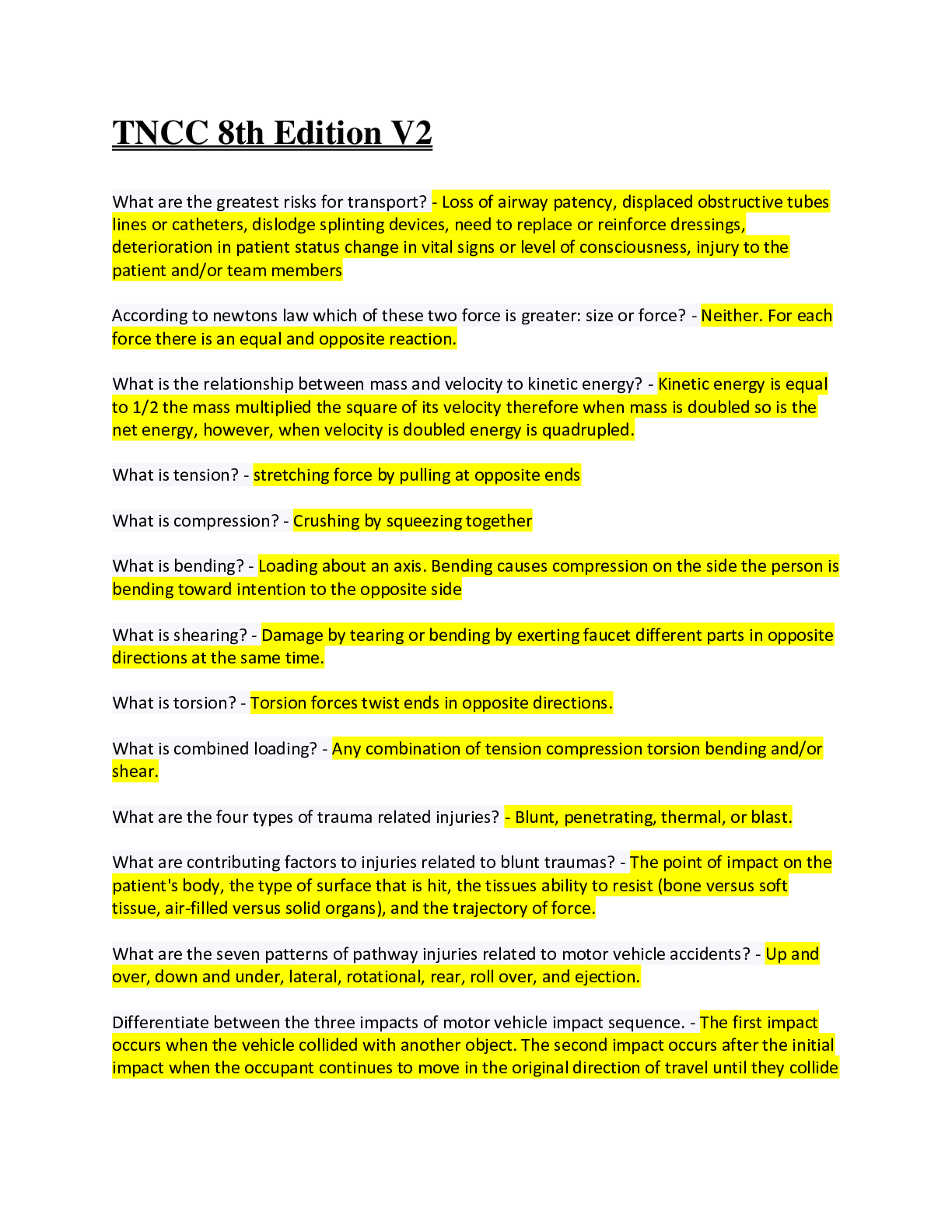
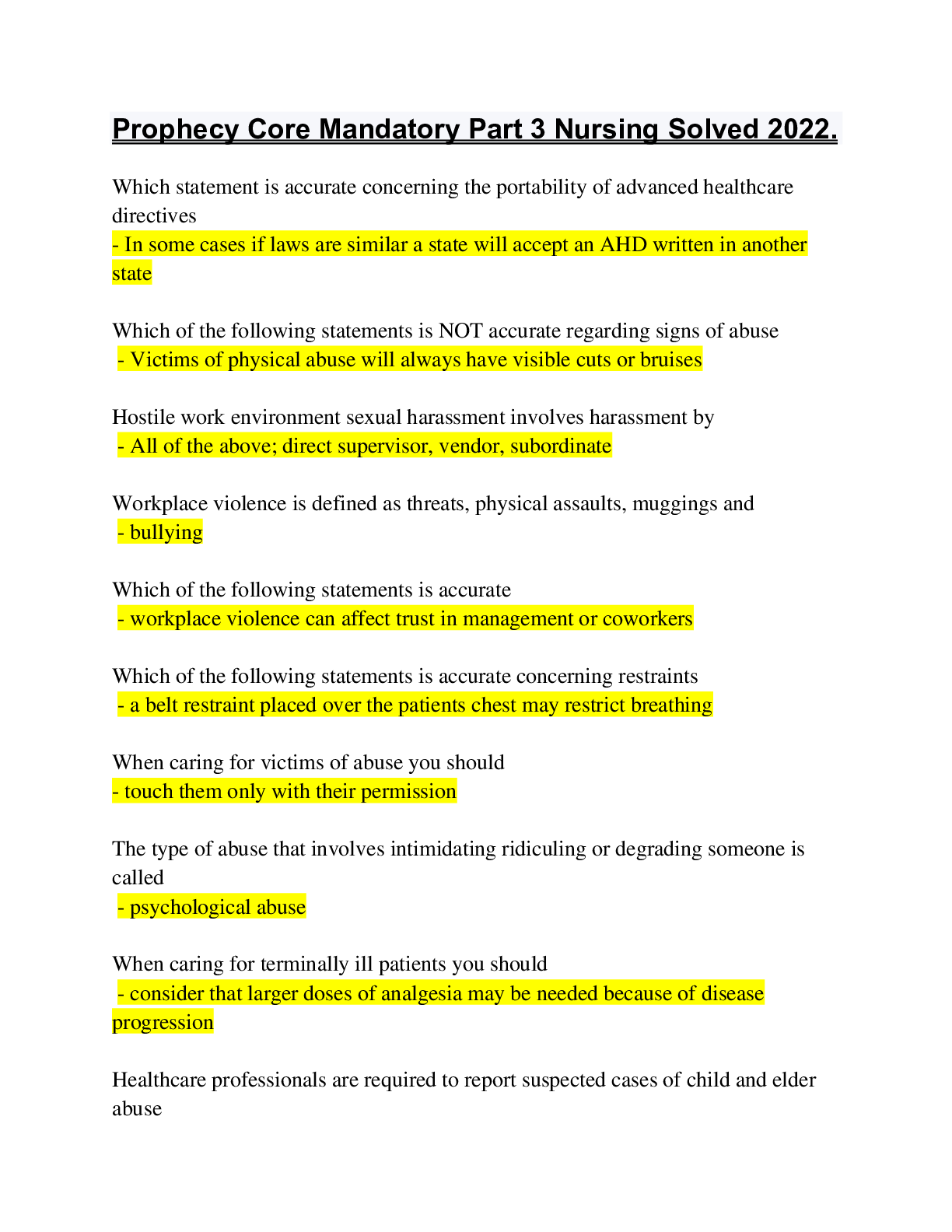
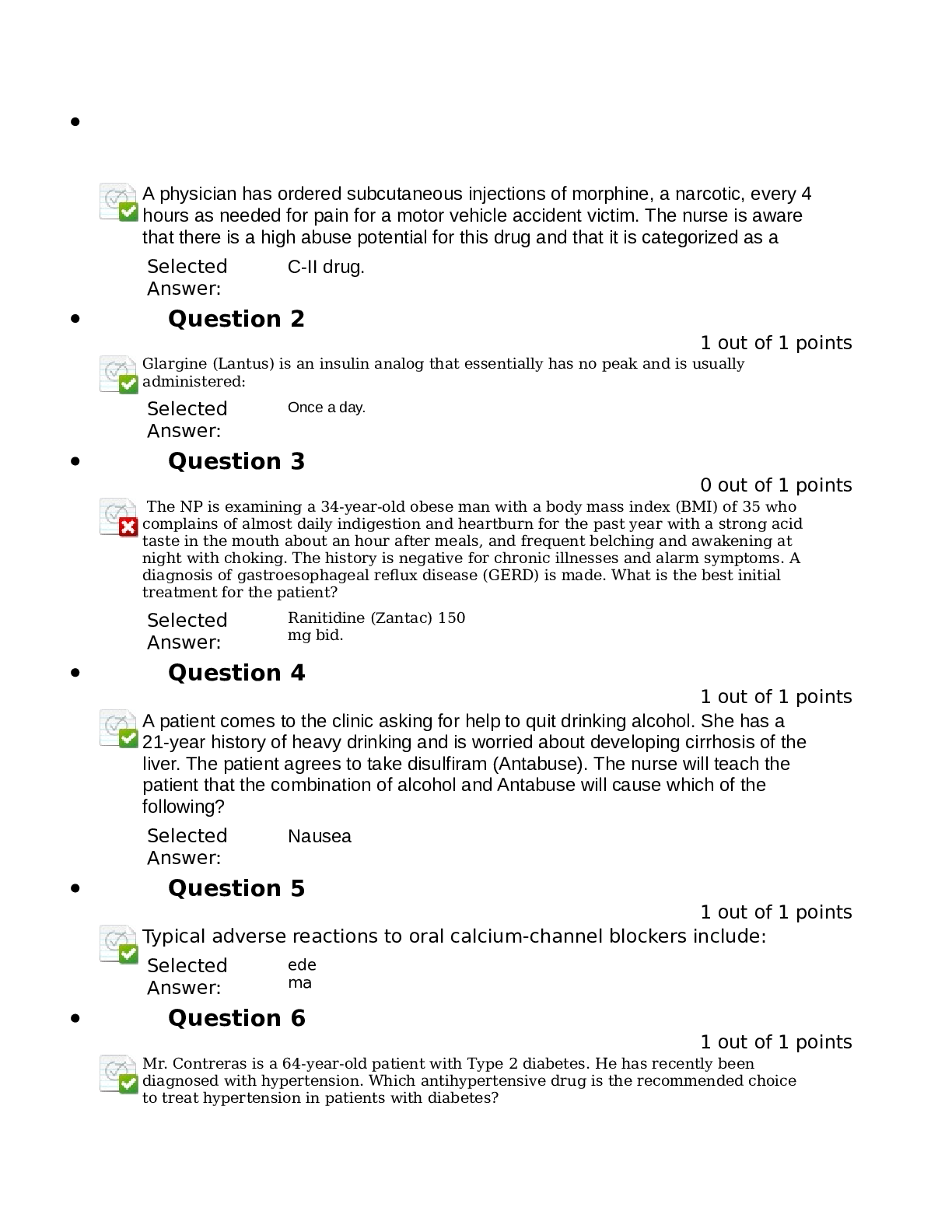
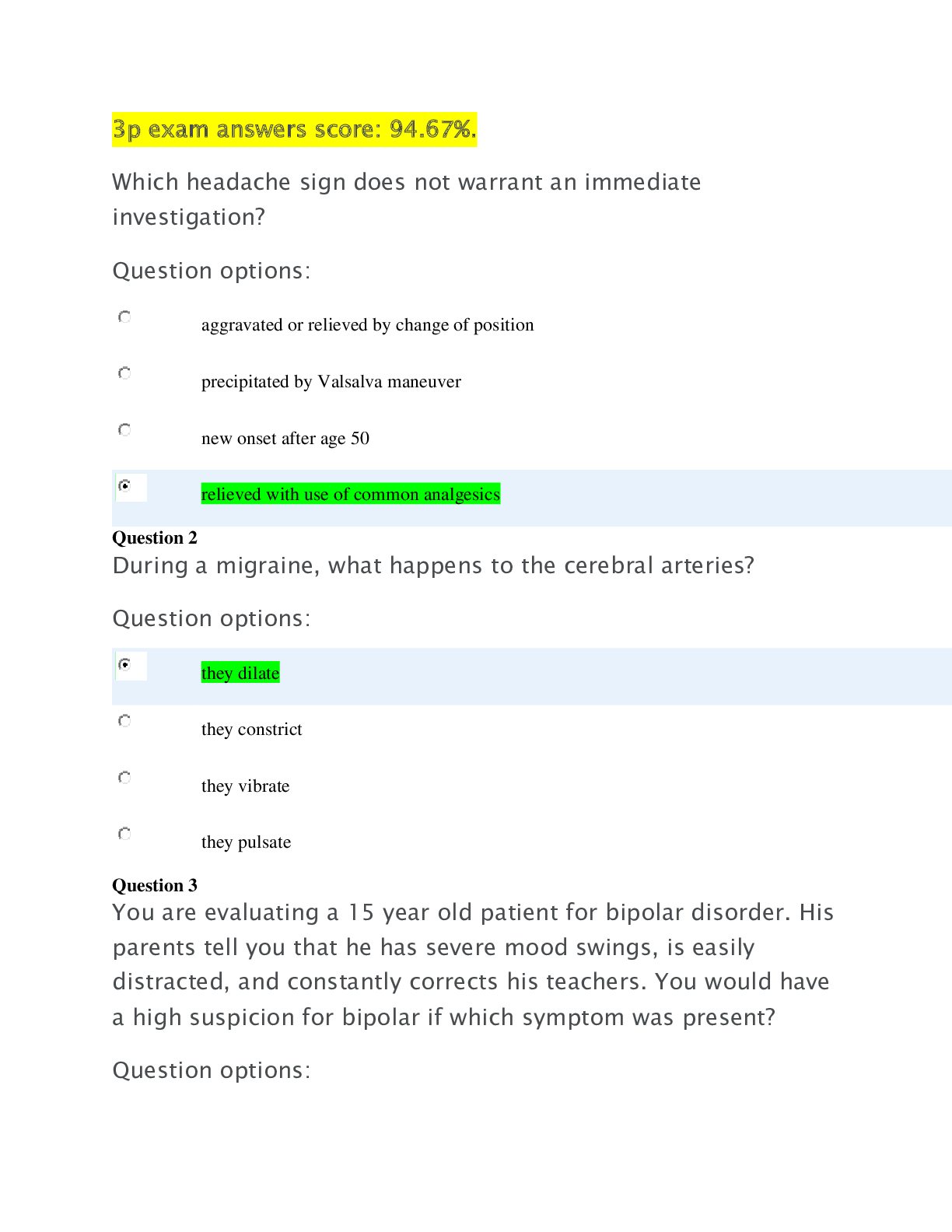
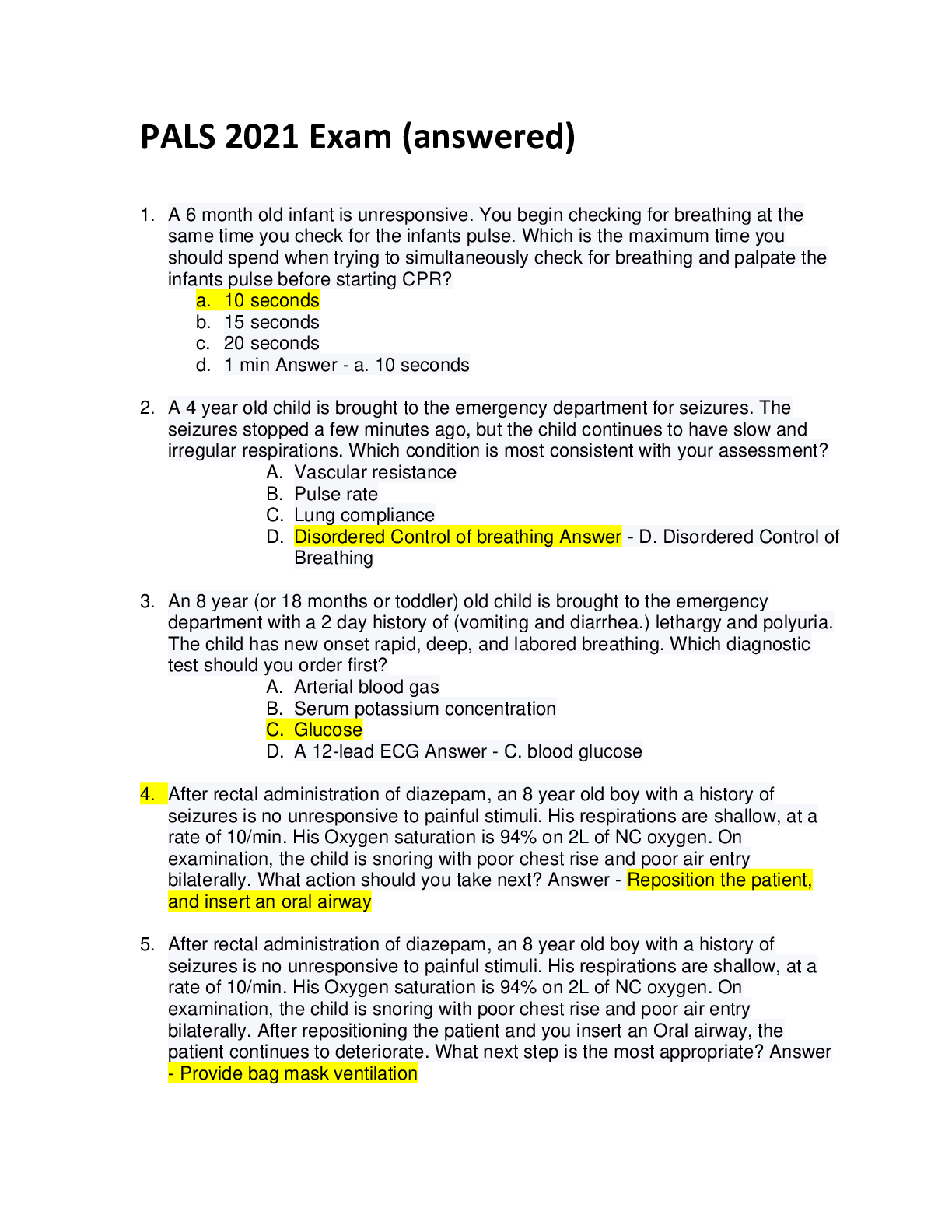
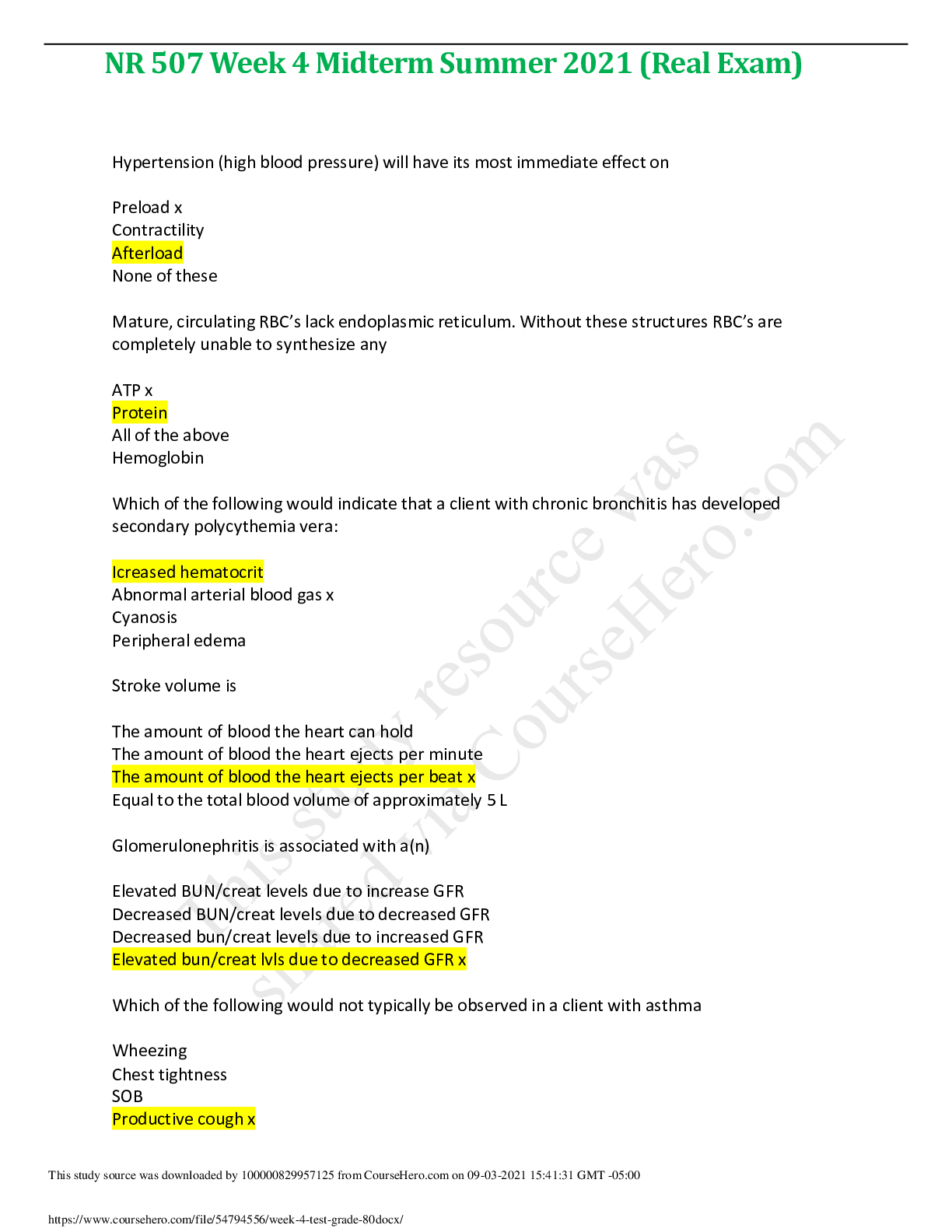


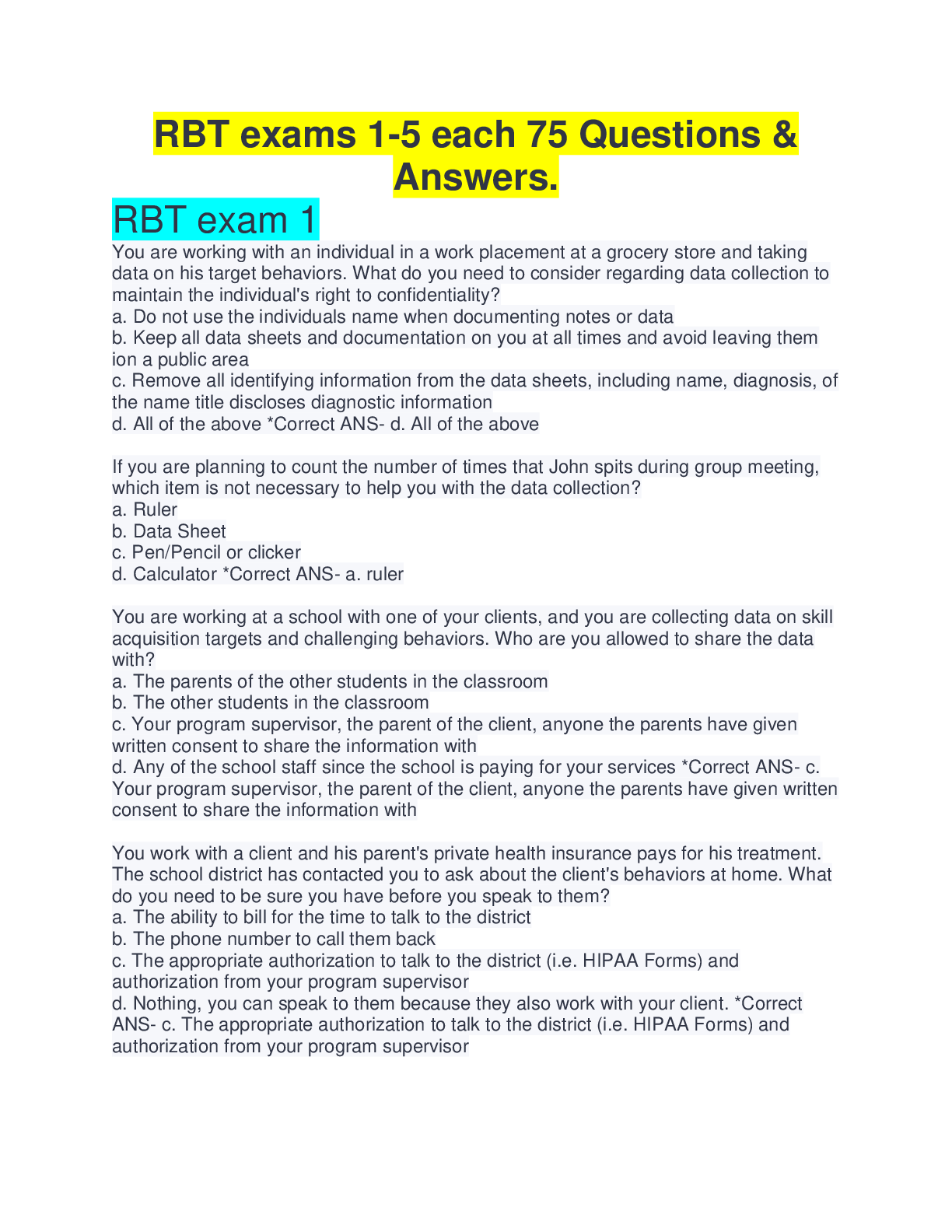


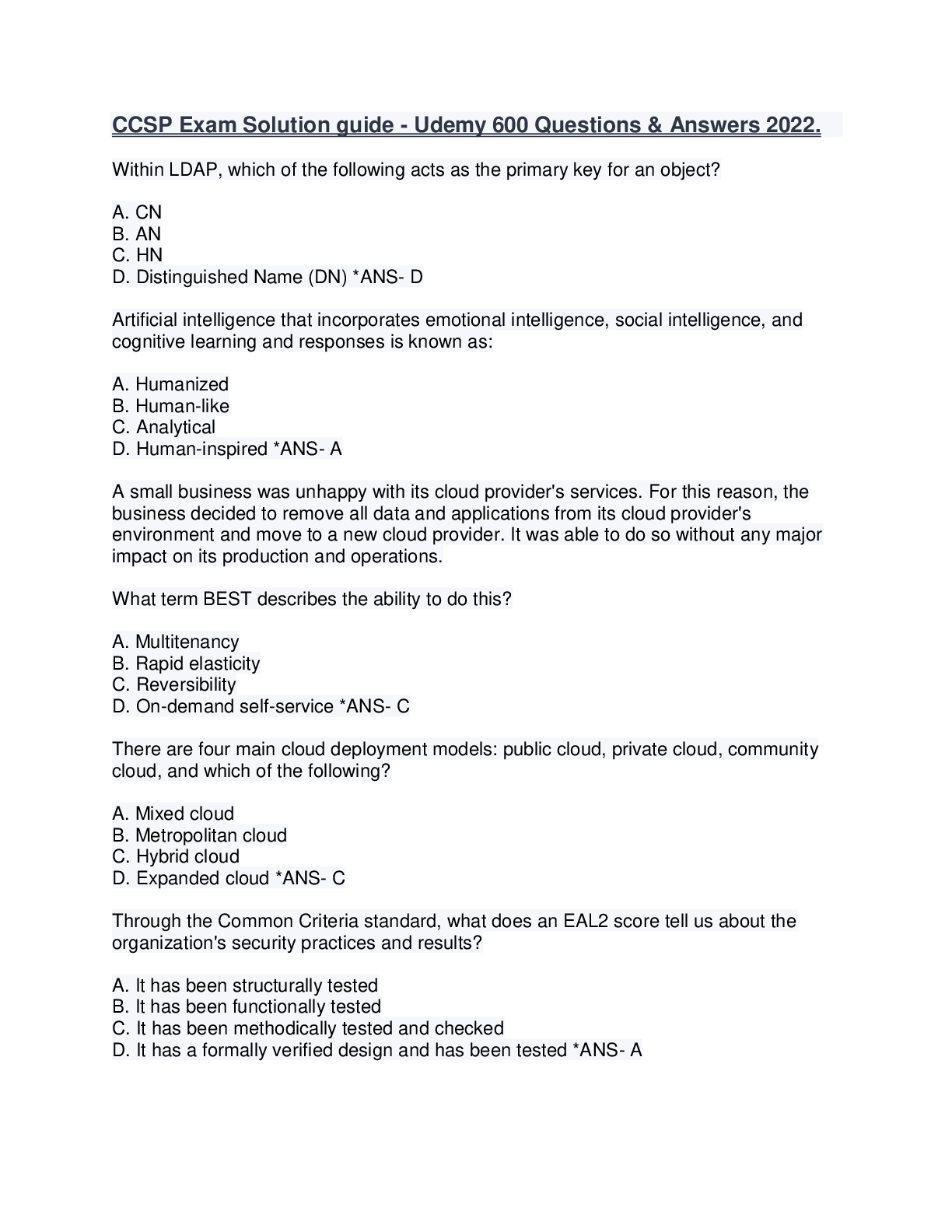
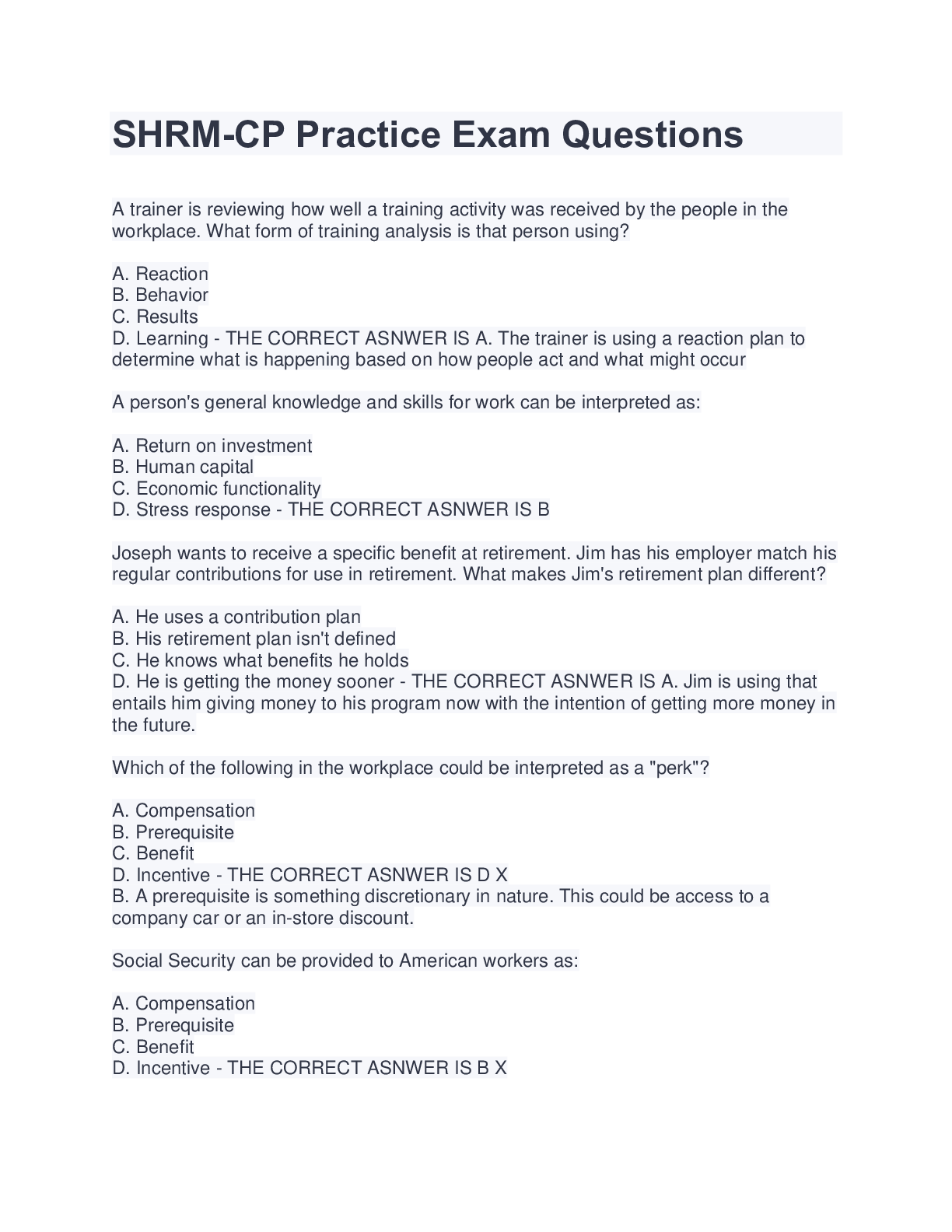

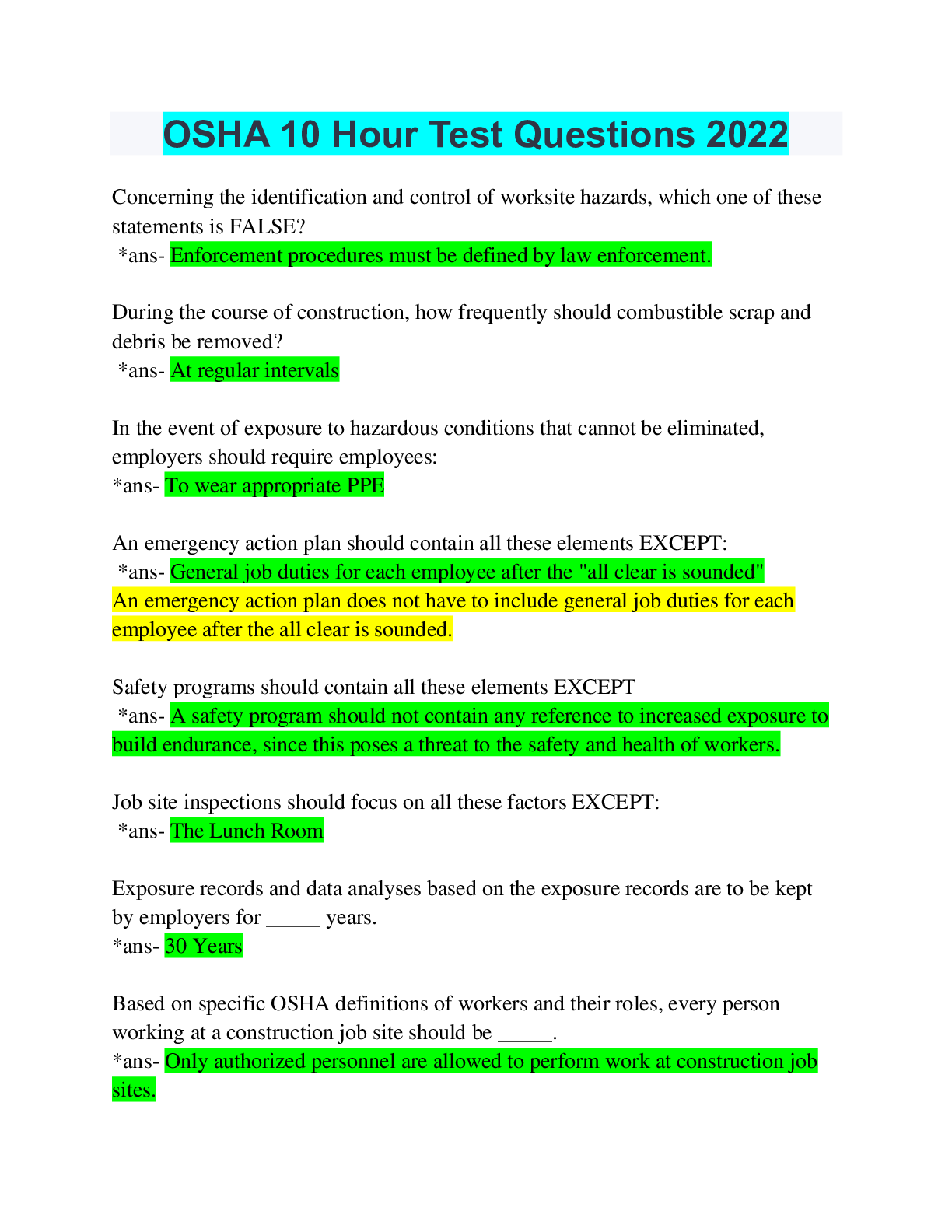
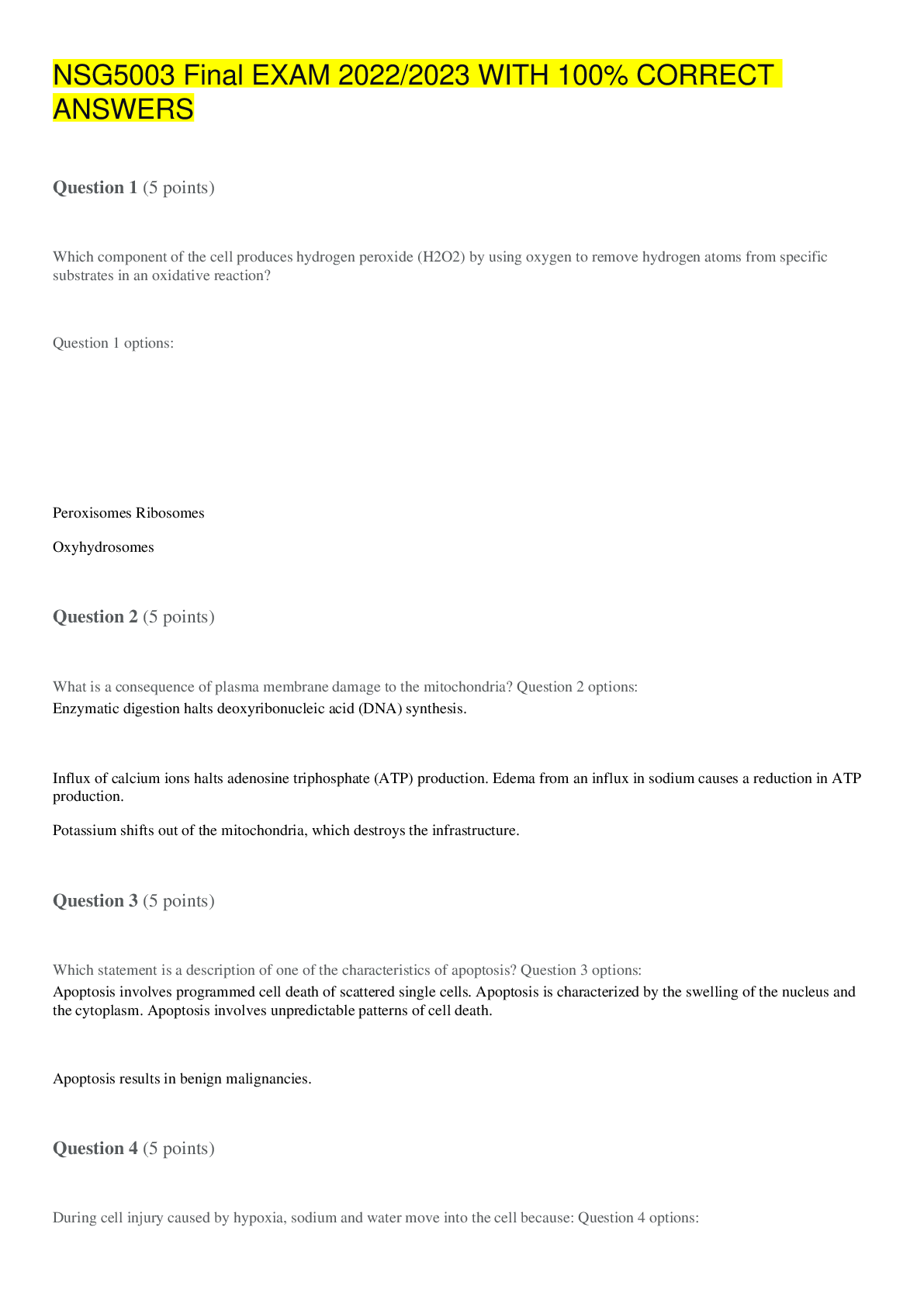
 (1).png)
 (1).png)
 (1).png)
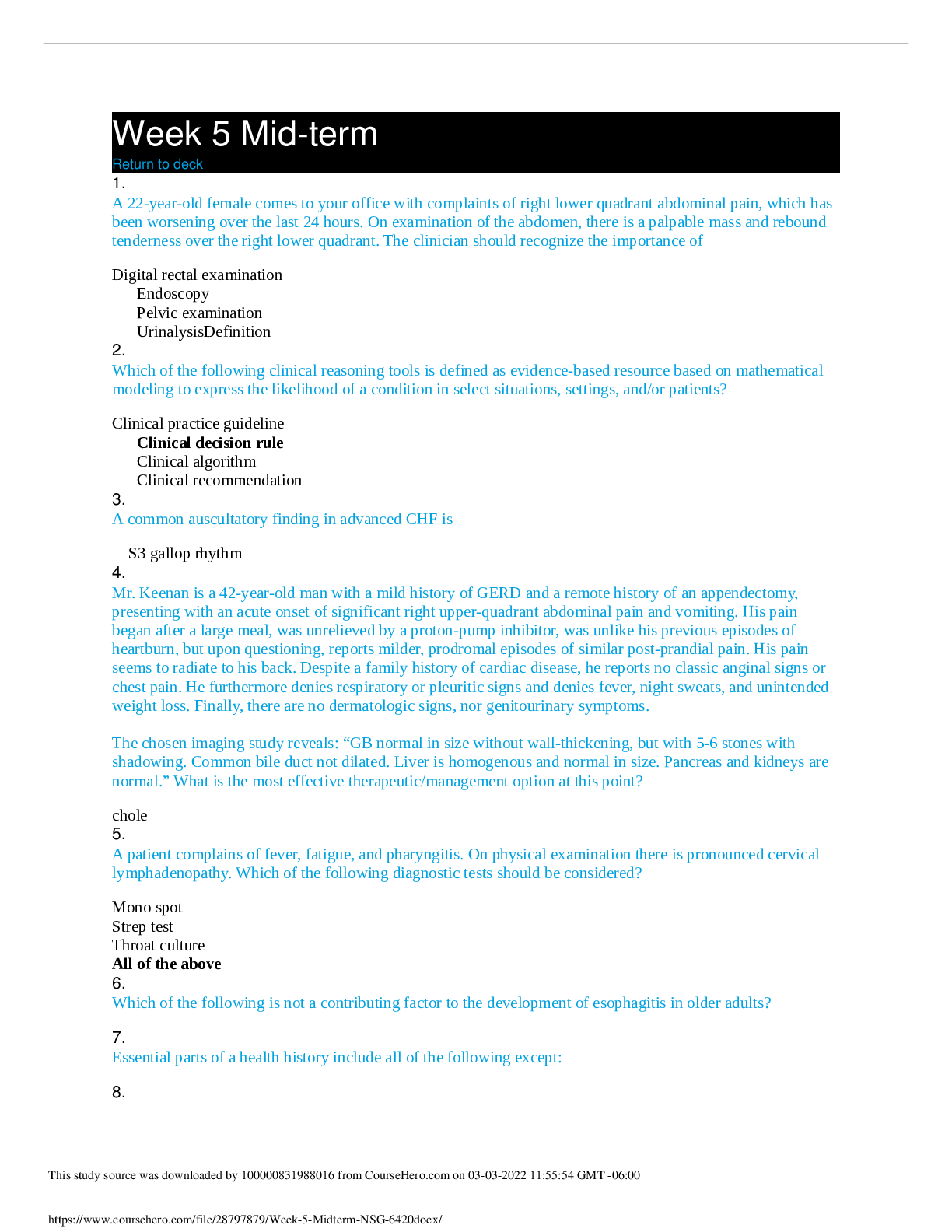
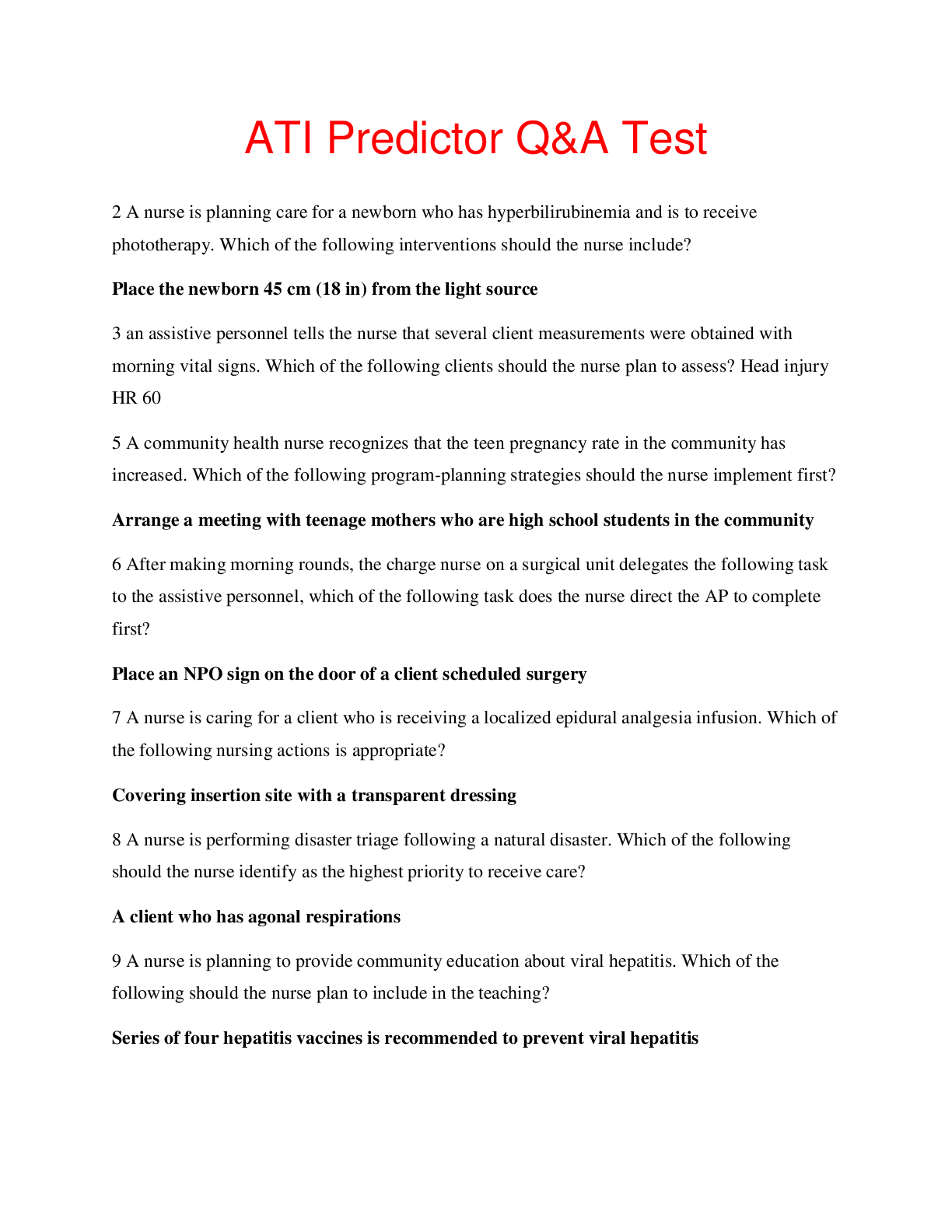

.png)
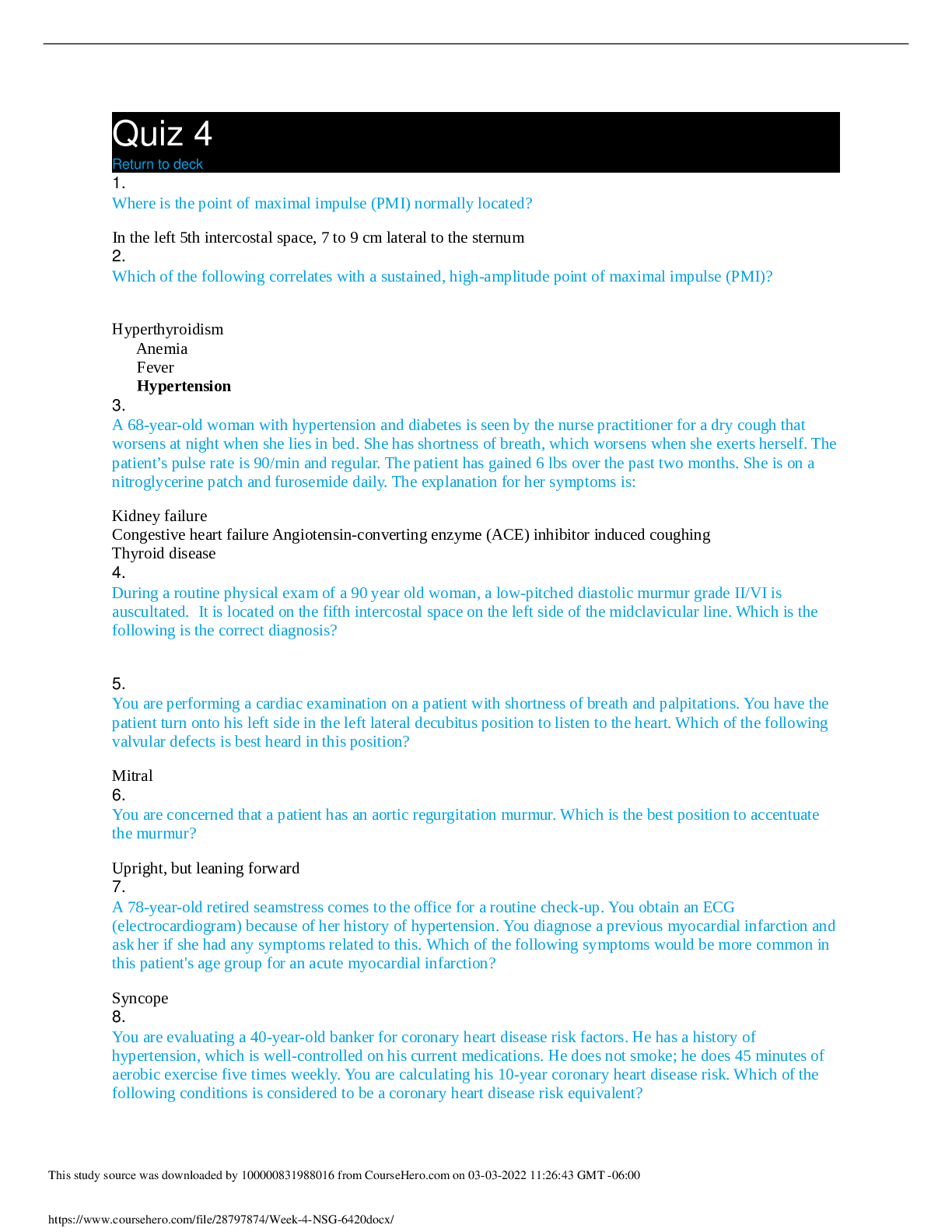
.png)
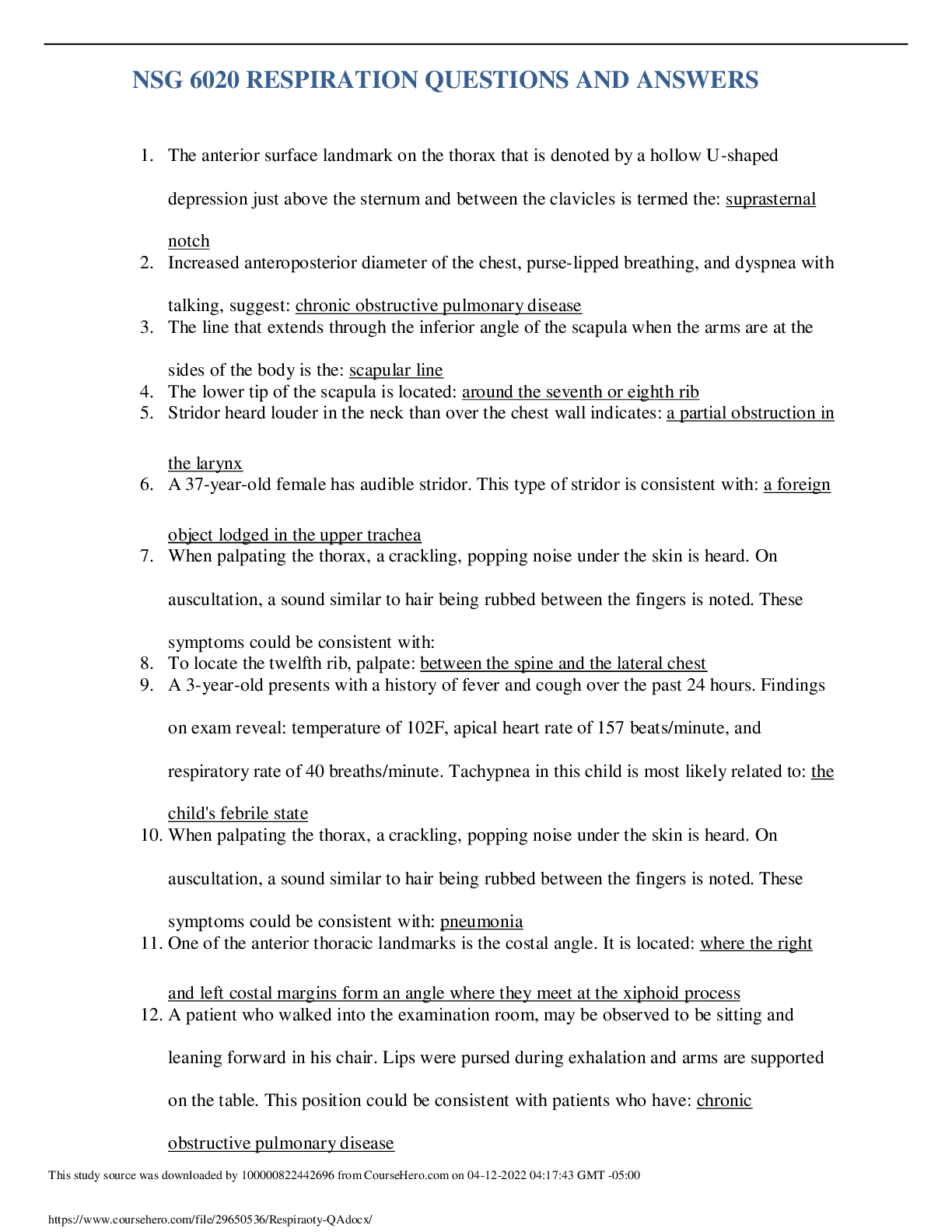

.png)
.png)
